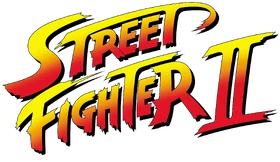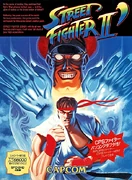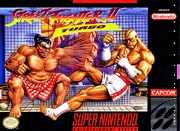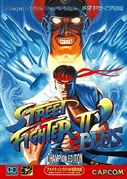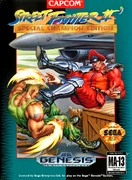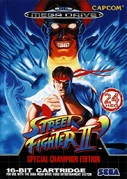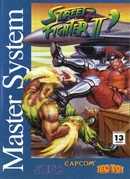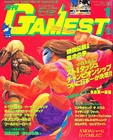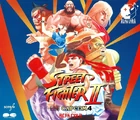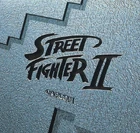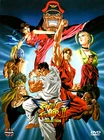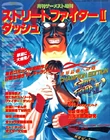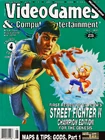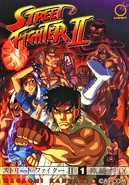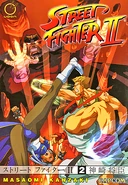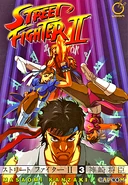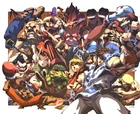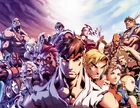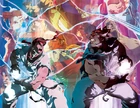| Line 147: | Line 147: | ||
==Reception== |
==Reception== |
||
| − | ===Critical reception=== |
||
| − | {| class="wikitable collapsible" style="float:right; font-size:80%; text-align:center; margin:1em; margin-top:0; padding:0; background:none;" cellpadding="0" |
||
| − | ! colspan=11 style="font-size: 120%" | Reception |
||
| − | |- |
||
| − | ! colspan=11 | Aggregate scores |
||
| − | |- |
||
| − | ! rowspan=2 | Aggregator |
||
| − | ! colspan=10 | Scores |
||
| − | |- |
||
| − | ! [[Arcade game|Arcade]] |
||
| − | ! [[Super Nintendo Entertainment System|SNES]] |
||
| − | ! [[Amiga|AMI]] |
||
| − | ! [[IBM PC compatible|PC]] |
||
| − | ! [[Commodore 64|C64]] |
||
| − | ! [[Atari ST|ST]] |
||
| − | ! [[ZX Spectrum|ZX]] |
||
| − | ! [[Game Boy]] |
||
| − | ! [[Wii]] |
||
| − | ! [[Wii U]] |
||
| − | |- |
||
| − | | Defunct<br />Games |
||
| − | | |
||
| − | | 93%<ref name="defunct_games"/> |
||
| − | | |
||
| − | | |
||
| − | | |
||
| − | | |
||
| − | | |
||
| − | | |
||
| − | | |
||
| − | | |
||
| − | |- |
||
| − | | [[GameRankings]] |
||
| − | | |
||
| − | | 90%<ref name="gr_snes">{{cite web|url=http://www.gamerankings.com/snes/588700-street-fighter-ii/index.html|title=Street Fighter II|publisher=Game Rankings |accessdate=March 2, 2012 |archiveurl=https://web.archive.org/web/20120102133523/http://www.gamerankings.com/snes/588700-street-fighter-ii/index.html |archivedate=January 2, 2012}}</ref> |
||
| − | | |
||
| − | | |
||
| − | | |
||
| − | | |
||
| − | | |
||
| − | | |
||
| − | | |
||
| − | | |
||
| − | |- |
||
| − | ! colspan=11 | [[Video game journalism|Review scores]] |
||
| − | |- |
||
| − | ! rowspan=2 | Publication |
||
| − | ! colspan=10 | Scores |
||
| − | |- |
||
| − | ! [[Arcade game|Arcade]] |
||
| − | ! [[Super Nintendo Entertainment System|SNES]] |
||
| − | ! [[Amiga|AMI]] |
||
| − | ! [[IBM PC compatible|PC]] |
||
| − | ! [[Commodore 64|C64]] |
||
| − | ! [[Atari ST|ST]] |
||
| − | ! [[ZX Spectrum|ZX]] |
||
| − | ! [[Game Boy]] |
||
| − | ! [[Wii]] |
||
| − | ! [[Wii U]] |
||
| − | |- |
||
| − | | [[AllGame]] |
||
| − | | {{Rating|5|5}}<ref>{{cite web|url=http://allgame.com/game.php?id=9378 |title=Street Fighter II - The World Warrior Review |publisher=[[AllGame]] |date= |accessdate=February 17, 2016|archiveurl=https://web.archive.org/web/20141114145104/http://www.allgame.com/game.php?id=9378|archivedate=November 14, 2014|last=Miller|first=Skyler}}</ref> |
||
| − | | {{Rating|4.5|5}}<ref>{{cite web|archiveurl=https://web.archive.org/web/20141114221802/http://www.allgame.com/game.php?id=2615&tab=review|url=http://www.allgame.com/game.php?id=2615&tab=review|accessdate=February 17, 2016|title=Street Fighter II: The World Warrior|last=Kosydar|first=Aaron|archivedate=November 14, 2014}}</ref> |
||
| − | | |
||
| − | | colspan=2 | {{Rating|2.5|5}}<ref>{{Allgame|22989|Street Fighter II: The World Warrior (Commodore 64/128)}}<br />{{Allgame|14458|Street Fighter II: The World Warrior (PC)}}</ref> |
||
| − | | |
||
| − | | |
||
| − | | {{Rating|4|5}}<ref>{{cite web|url=http://www.allgame.com/game.php?id=7356&tab=review|archivedate=November 15, 2014 |archiveurl=https://web.archive.org/web/20141115075408/http://www.allgame.com/game.php?id=7356&tab=review|accessdate=February 17, 2016|last=Williamson|first=Colin|publisher=[[AllGame]]|title=Street Fighter II: The World Warrior}}</ref> |
||
| − | | {{Rating|3.5|5}}<ref>{{Allgame|51676|Street Fighter II: The World Warrior [Virtual Console] (Wii)}}</ref> |
||
| − | | {{Rating|4|5}}<ref>{{Allgame|83042|Street Fighter II: The World Warrior [Virtual Console] (Wii U)}}</ref> |
||
| − | |- |
||
| − | | ''[[Bad Influence!]]'' |
||
| − | | |
||
| − | | 96%<ref>[http://www.bad-influence.co.uk/downloads/mag/BI_issue1.pdf#page=16] {{dead link|date=March 2016}}</ref> |
||
| − | | |
||
| − | | |
||
| − | | |
||
| − | | |
||
| − | | |
||
| − | | |
||
| − | | |
||
| − | | |
||
| − | |- |
||
| − | | ''[[Commodore User#CU Amiga|CU Amiga]]'' |
||
| − | | |
||
| − | | |
||
| − | | 90%<ref>{{cite web|url=http://amigareviews.classicgaming.gamespy.com/streetf2.htm#streetfighter2cu|archiveurl=https://web.archive.org/web/20090427191157/http://amigareviews.classicgaming.gamespy.com/streetf2.htm#streetfighter2cu|title=Amiga Reviews: Street fighter 2|author=Tim Janssen|archivedate=April 27, 2009|website=Web.archive.org|accessdate=January 18, 2015}}</ref> |
||
| − | | |
||
| − | | |
||
| − | | |
||
| − | | |
||
| − | | |
||
| − | | |
||
| − | | |
||
| − | |- |
||
| − | | ''[[Computer and Video Games|CVG]]'' |
||
| − | | 93%<ref>{{cite web|url=https://archive.org/stream/cvg-magazine-115/CVG_115_Jun_1991#page/n119/mode/2up|title=CVG Magazine Issue 115|website=Archive.org|accessdate=January 18, 2015}}</ref> |
||
| − | | |
||
| − | | |
||
| − | | |
||
| − | | |
||
| − | | |
||
| − | | |
||
| − | | |
||
| − | | |
||
| − | | |
||
| − | |- |
||
| − | | ''[[Edge (magazine)|Edge]]'' |
||
| − | | |
||
| − | | 9/10<ref>{{cite web|title=Street Fighter II Turbo Review|work=[[Edge (magazine)|Edge]]|publisher=[[Future plc|Future Publishing]]| date=October 1993 |issue=1|url=http://www.edge-online.com/review/street-fighter-2-turbo-review/|accessdate=November 20, 2012}}</ref> |
||
| − | | |
||
| − | | |
||
| − | | |
||
| − | | |
||
| − | | |
||
| − | | |
||
| − | | |
||
| − | | |
||
| − | |- |
||
| − | | ''[[Electronic Gaming Monthly|EGM]]'' |
||
| − | | |
||
| − | | 38/40<ref name="egmbuyersguide1993"/> |
||
| − | | |
||
| − | | |
||
| − | | |
||
| − | | |
||
| − | | |
||
| − | | 29/40<ref name="EGM76"/> |
||
| − | | |
||
| − | | |
||
| − | |- |
||
| − | | ''[[Electronic Games|Electronic<br />Games]]'' |
||
| − | | |
||
| − | | 94%<ref name="eg_review">{{cite web|url=https://archive.org/stream/Electronic-Games-1992-10/Electronic%20Games%201992-10#page/n71/mode/2up|title=Electronic Games 1992-10|website=archive.org|accessdate=January 18, 2015}}</ref> |
||
| − | | |
||
| − | | |
||
| − | | |
||
| − | | |
||
| − | | |
||
| − | | |
||
| − | | |
||
| − | | |
||
| − | |- |
||
| − | | ''[[Famitsu]]'' |
||
| − | | |
||
| − | | 35/40<ref name="famitsu">{{cite web|title=Famitsu Hall of Fame|url=http://geimin.net/da/db/cross_review/|work=Geimin|accessdate=February 7, 2012}}</ref> |
||
| − | | |
||
| − | | |
||
| − | | |
||
| − | | |
||
| − | | |
||
| − | | 21/40<ref>''Famitsu'', [http://www.famitsu.com/cominy/?m=pc&a=page_h_title&title_id=20720 issue 349]</ref> |
||
| − | | |
||
| − | | |
||
| − | |- |
||
| − | | ''[[GamePro]]'' |
||
| − | | |
||
| − | | 5/5<ref name="defunct_games"/> |
||
| − | | |
||
| − | | |
||
| − | | |
||
| − | | |
||
| − | | |
||
| − | | |
||
| − | | |
||
| − | | |
||
| − | |- |
||
| − | | [[GameSpot]] |
||
| − | | |
||
| − | | |
||
| − | | |
||
| − | | |
||
| − | | |
||
| − | | |
||
| − | | |
||
| − | | |
||
| − | | 7.2/10<ref>{{cite web|url=http://www.gamespot.com/reviews/street-fighter-ii-the-world-warrior-review/1900-6164369/ |title=Street Fighter II - The World Warrior Review |publisher=GameSpot.com |date=January 18, 2007}}</ref> |
||
| − | | |
||
| − | |- |
||
| − | | [[IGN]] |
||
| − | | |
||
| − | | |
||
| − | | |
||
| − | | |
||
| − | | |
||
| − | | |
||
| − | | |
||
| − | | |
||
| − | | 7/10<ref>{{cite web|url=http://ign.com/articles/2007/01/17/street-fighter-ii-vc-review|title=Street Fighter II VC Review|work=IGN|accessdate=January 18, 2015}}</ref> |
||
| − | | |
||
| − | |- |
||
| − | | {{ill|Jeuxvideo|fr|Jeuxvideo.com|vertical-align=sup}} |
||
| − | | |
||
| − | | |
||
| − | | |
||
| − | | |
||
| − | | |
||
| − | | |
||
| − | | |
||
| − | | |
||
| − | | 18/20<ref>{{cite web|url=http://www.jeuxvideo.com/articles/0001/00012218-street-fighter-ii-the-world-warrior-test.htm|title=Test du jeu Street Fighter II : The World Warrior sur Wii - jeuxvideo.com|work=Jeuxvideo.com|accessdate=January 18, 2015}}</ref> |
||
| − | | |
||
| − | |- |
||
| − | | ''[[Mean Machines|Mean<br />Machines]]'' |
||
| − | | |
||
| − | | 98%<ref>{{cite web|url=http://www.meanmachinesmag.co.uk/review/352/street-fighter-ii-the-world-warrior.php|title=Street Fighter II: The World Warrior - Super Nintendo - Mean Machines review|website=Meanmachinesmag.co.uk|accessdate=January 18, 2015}}</ref> |
||
| − | | |
||
| − | | |
||
| − | | |
||
| − | | |
||
| − | | |
||
| − | | |
||
| − | | |
||
| − | | |
||
| − | |- |
||
| − | | ''[[Mega Zone]]'' |
||
| − | | |
||
| − | | 95%<ref>{{cite web|url=http://amr.abime.net/review_30941|title=Street Fighter 2 review from MegaZone 24 (Oct - Nov 1992) - Amiga Magazine Rack|website=Amr.abime.net|accessdate=January 18, 2015}}</ref> |
||
| − | | colspan=2 | 84%<ref>{{cite web|url=http://amr.abime.net/review_47404|title=Street Fighter 2 review from MegaZone 29 (Jul 1993) - Amiga Magazine Rack|website=Amr.abime.net|accessdate=January 18, 2015}}</ref> |
||
| − | | |
||
| − | | |
||
| − | | |
||
| − | | |
||
| − | | |
||
| − | | |
||
| − | |- |
||
| − | | ''[[Nintendo Power|Nintendo<br />Power]]'' |
||
| − | | |
||
| − | | 4.075/5<ref name="gr_snes"/> |
||
| − | | |
||
| − | | |
||
| − | | |
||
| − | | |
||
| − | | |
||
| − | | |
||
| − | | |
||
| − | | |
||
| − | |- |
||
| − | | ''[[Sinclair User]]'' |
||
| − | | 84%<ref name="su_arc">{{cite web|url=http://www.solvalou.com/subpage/arcade_reviews/140/334/street_fighter_ii_review.html|title=Street Fighter II arcade game review|website=Solvalou.com|accessdate=January 18, 2015}}</ref> |
||
| − | | |
||
| − | | |
||
| − | | |
||
| − | | |
||
| − | | |
||
| − | | 89%<ref>{{cite web|url=http://www.worldofspectrum.org/showmag.cgi?mag=SinclairUser/Issue133/Pages/SinclairUser13300010.jpg |title=Archive - Magazine viewer |publisher=World of Spectrum |accessdate=August 17, 2012}}</ref> |
||
| − | | |
||
| − | | |
||
| − | | |
||
| − | |- |
||
| − | | ''[[ST Format]]'' |
||
| − | | |
||
| − | | |
||
| − | | |
||
| − | | |
||
| − | | |
||
| − | | 91%<ref>{{cite web|url=http://www.atarimania.com/atari-magazine-issue-st-format-issue-44_1207.html|title=ST Format (Issue 44) - March - 1993|website=Atarimania.com|accessdate=January 18, 2015}}</ref> |
||
| − | | |
||
| − | | |
||
| − | | |
||
| − | | |
||
| − | |- |
||
| − | | ''[[Super Play]]'' |
||
| − | | |
||
| − | | 94%<ref name="gr_snes"/> |
||
| − | | |
||
| − | | |
||
| − | | |
||
| − | | |
||
| − | | |
||
| − | | |
||
| − | | |
||
| − | | |
||
| − | |- |
||
| − | | ''[[Your Sinclair]]'' |
||
| − | | |
||
| − | | |
||
| − | | |
||
| − | | |
||
| − | | |
||
| − | | |
||
| − | | 62%<ref>{{cite web |url=http://www.ysrnry.co.uk/articles/streetfighterii.htm |title=Street Fighter II |publisher=Ysrnry.co.uk |accessdate=August 17, 2012 |deadurl=yes |archiveurl=https://web.archive.org/web/20120621133736/http://www.ysrnry.co.uk/articles/streetfighterii.htm |archivedate=June 21, 2012 |df= }}</ref> |
||
| − | | |
||
| − | | |
||
| − | | |
||
| − | |- |
||
| − | ! colspan=11 | Awards |
||
| − | |- |
||
| − | ! colspan="5" | Publication(s) |
||
| − | ! colspan=6 | Award(s) |
||
| − | |- |
||
| − | | colspan=5 | [[:jp:ゲーメスト大賞|''Gamest'' Grand Prize]] {{nowrap|(1991 & 1992)}}, ''[[Electronic Gaming Monthly|EGM]]'' (1992),<br />[[Golden Joystick Award]]s (1992), ''[[Game Informer]]'' (1992) |
||
| − | | colspan=6 | [[Game of the Year]] |
||
| − | |- |
||
| − | | colspan=5 | [[GamePro]] (1992) |
||
| − | | colspan=6 | 16-bit Game of the Year |
||
| − | |- |
||
| − | | colspan=5 | [[Electronic Games|Electronic Gaming Awards]] (1992) |
||
| − | | colspan=6 | Video Game of the Year (Nominee) |
||
| − | |- |
||
| − | | colspan=5 | ''[[Electronic Gaming Monthly]]'' {{nowrap|(1992 & 1993)}} |
||
| − | | colspan=6 | Best Game of the Year (Super Nintendo) |
||
| − | |- |
||
| − | | colspan=5 | [[:jp:ゲーメスト大賞|''Gamest'' Grand Prize]] {{nowrap|(1991 & 1992)}} |
||
| − | | colspan=6 | [[Action game|Best Action Game]], [[Image song|Best Album]] |
||
| − | |- |
||
| − | | colspan=5 | [[:jp:ゲーメスト大賞|''Gamest'' Grand Prize]] (1991) |
||
| − | | colspan=6 | [[Video game music|Best VGM]], Best Direction, Best Characters,<br />Best Graphics (Runner-Up) |
||
| − | |- |
||
| − | | colspan=5 | ''[[Electronic Gaming Monthly]]'' (1992) |
||
| − | | colspan=6 | Best Video Game Ending,<br />Hottest Video Game Babe (Chun-Li) |
||
| − | |- |
||
| − | | colspan=5 | ''[[Game Informer]]'' (1992) |
||
| − | | colspan=6 | Best Playability in a Video Game |
||
| − | |- |
||
| − | | colspan=5 | ''[[MegaTech]]'' (1993) |
||
| − | | colspan=6 | Hyper Game |
||
| − | |- |
||
| − | | colspan=5 | ''[[Guinness World Records Gamer's Edition]]'' |
||
| − | | colspan=6 | First Fighting Game to Use Combos, Most Cloned Fighting Game,<br />Biggest-Selling Coin-Operated Fighting Game |
||
| − | |- |
||
| − | | colspan=5 | [[BuzzFeed]], ''[[Edge (magazine)|Edge]]'', ''[[Electronic Gaming Monthly|EGM]]'', ''[[Empire (film magazine)|Empire]]'', ''[[Famitsu]]'', ''[[FHM]]'', [[G4 (U.S. TV channel)|G4]], [[GameFAQs]],<br />''[[Game Informer]]'', [[GameSpot]], [[GameRevolution|GamingBolt]], ''[[Guinness World Records|Guinness]]'', [[IGN]],<br />''[[Next Generation (magazine)|Next Generation]]'', [[Imagine Publishing|NowGamer]], ''[[Retro Gamer]]'', ''[[Stuff (magazine)|Stuff]]'', ''[[Time (magazine)|Time]]'', [[Yahoo!]] |
||
| − | | colspan=6 | [[List of video games considered the best|Best Games of All Time]] |
||
| − | |} |
||
| − | |||
| − | ;Japan |
||
| − | |||
| − | In the February 1992 issue of ''Gamest'' magazine in Japan, it was revealed that due to low stock the games were selling for seven times the cost (¥15,000 in Japan, equivalent to about $119.19 and £65 at the time). The original arcade version of ''Street Fighter II'' was awarded Best Game of 1991 in their Fifth Annual Grand Prize, which also won in the genre of Best Action Game (the award for fighting games was not established yet). ''Street Fighter II'' also placed No. 1 in Best VGM, Best Direction, and Best Album, and was second place in Best Graphics (below the 3D Namco System 21 game ''[[wikipedia:StarBlade|Starblade]]''). All the characters, with the exception of M. Bison (the character known internationally as Balrog), were featured on the list of Best Characters of 1991, with Chun-Li at No. 1, Ryu at No. 3, Guile at No. 4, Dhalsim at No. 5, Zangief at No. 6, Edmond Honda at No. 8, Ken and Blanka sharing the No. 9 spot, Vega (M. Bison outside Japan) at No. 13, Balrog (Vega outside Japan) at No. 16, and Sagat at No. 22.<ref name=gamest68>https://web.archive.org/web/20080708023228/http://www.netlaputa.ne.jp/~dummy/gamest/magazine/gamest/v068.html</ref> |
||
| − | |||
| − | In the following year, ''Street Fighter II Dash'' was also awarded Best Game of 1992 in the Sixth Annual Grand Prize, as published in the February 1993 issue of ''Gamest'', winning once again in the category of Best Action Game. ''Dash'' placed No. 3 in Best VGM, No. 6 in Best Graphics, No. 5 in Best Direction. The ''Street Fighter II Image Album'' was the No. 1 Best Album in the same issue, with the Drama CD version of ''Street Fighter II'' tied for No. 7 with the soundtrack for ''Star Blade''. The List of Best Characters was not dominated by ''Street Fighter II'' characters this time, with the only character at the Top Ten being Chun-Li at No. 3.<ref name=gamest84>https://web.archive.org/web/20080708023308/http://www.netlaputa.ne.jp/~dummy/gamest/magazine/gamest/v084.html</ref> |
||
| − | |||
| − | In the February 1994 issue of ''Gamest'', both ''Street Fighter II Dash Turbo'' (''Hyper Fighting'') and ''Super Street Fighter II'' were nominated for Best Game of 1993, but neither won (the first place was given to ''[[w:c:snk:Samurai Shodown|Samurai Spirits]]''). ''Super'' ranked third place, with ''Turbo'' at No. 6. In the category of Best Fighting Games, ''Super'' ranked third place again, while ''Turbo'' placed fifth. ''Super'' also won third place in the categories of Best Graphics and Best VGM. Cammy, who was introduced in ''Super'', placed fifth place in the list of Best Characters of 1993, with Dee Jay and T. Hawk at 36 and 37.<ref name=gamest107>http://www.netlaputa.ne.jp/~dummy/gamest/magazine/gamest/v107.html</ref> In the January 30, 1995 issue of ''Gamest'', ''Super Street Fighter II X'' (known as ''Super Turbo'' internationally) placed fourth place in the award for Best Game of 1994 and Best Fighting Game, but did not rank in any of the other awards.<ref name=gamest136>http://www.netlaputa.ne.jp/~dummy/gamest/magazine/gamest/v136.html</ref> |
||
| − | |||
| − | The Super Famicom (SNES) version was also critically acclaimed. ''Famitsu''<nowiki>'</nowiki>s panel of four reviewers gave it scores of 9, 9, 9, and 8, adding up to 35 out of 40. This made it one of their five highest-rated games of 1992, along with ''[[w:c:dragonquest:Dragon Quest V: Hand of the Heavenly Bride|Dragon Quest V: Hand of the Heavenly Bride]]'', ''[[w:c:megamitensei:Shin Megami Tensei|Shin Megami Tensei]]'', ''[[World of Illusion Starring Mickey Mouse and Donald Duck]]'', and ''[[w:c:mario:Mario Paint|Mario Paint]]''. They later gave the ''Turbo'' update a score of 36 out of 40. This made ''Street Fighter II′ Turbo'' their highest-rated game of 1993, and the twelfth game to have received a ''Famitsu'' score of 36/40 or above.<ref name="famitsu"/> <!--In July 1995, ''Famitsu'' magazine's Family Game Cross Review gave the Super Famicom version a 28 out of 40.<ref>実験!! ゲーム家族のクロスレビュー: ストリートファイターII. Weekly Famicom Tsūshin. No.343. Pg.107. July 14, 1995.</ref>--> |
||
| − | |||
| − | ;'''Overseas''' |
||
| − | |||
| − | The arcade game was well received by English-language critics upon release. The June 1991 issue of ''Computer and Video Games'' (''CVG'') gave it ratings of 94% for graphics, 93% for sound, 95% for playability, and 92% for lastability, with a 93% score overall. The reviewer Julian Rignall criticized the original ''Street Fighter'' for being a "run-of-the-mill beat 'em up with little in the way of thrills and spills," but praised this sequel for being "absolutely packed with new ideas and special moves." He noted the "six buttons combining with 8 joystick directions to provide more moves than I've ever seen in a beat 'em up" and praised the "massive, beautifully drawn and animated sprites, tons of speech and the most exciting, action-packed head-to-head conflict yet seen in an arcade game," concluding that it is "one of the best fighting games yet seen in the arcades" and "a brilliant coin-op."<ref>https://archive.org/stream/cvg-magazine-115/CVG_115_Jun_1991#page/n117/mode/2up</ref> The June 1991 issue of ''Sinclair User'' gave the arcade game an "addict factor" of 84%. The reviewer John Cook criticized the controls, stating, "You might find the control system a bit daunting at first," noting "a joystick plus six (count 'em!) fire buttons," but said "it's not that bad really" and praised the gameplay as well as "excellent" animation and sound effects, concluding "this is bound to appeal to you if you like the beat 'em up style of game."<ref name="su_arc"/> |
||
| − | |||
| − | The SNES version of ''Street Fighter II'' was also very well received. It has an average aggregate score of 93% from Defunct Games based on ten reviews from the early 1990s.<ref name="defunct_games">http://www.defunctgames.com/reviewcrew/32/street-fighter-ii-what-did-critics-say-in-1992</ref> In ''Electronic Gaming Monthly'' (''EGM''), its panel of four reviewers gave it scores of 10, 9, 10, and 9, adding up to 38 out of 40,<ref name="egmbuyersguide1993">cite journal |last= |first= |authorlink= |year=1993 |title=Electronic Gaming Monthly's Buyer's Guide |journal=[[wikipedia:Electronic Gaming Monthly|Electronic Gaming Monthly]] |volume= |issue= |pages=13–24 |id= |url= |quote=</ref> and their "Game of the Month" award. Sushi X (Ken Williams), who gave it a 10, stated that it is "The Best! Street Fighter II is the only game I have ever seen that really deserves a 10!" Martin Alessi, who gave it a 9, described it as "the best cart available anywhere! Incredible game play!" Ed Semrad, who gave it a 10, said "The moves are perfect, the graphics outstanding and the audio exceptional. Get one of the new 6 button sticks and you'll swear you're playing the arcade version."<ref>https://archive.org/details/Electronic_Gaming_Monthly_036</ref> ''GamePro'' printed two reviews of the game in its August 1992 issue, both giving it a full score of 5 out of 5; Doctor Dave described it as "Capcom's best arcade conversion yet" while Slasher Quan stated that almost "everything's perfect in the Super NES version" and that it is "a nearly flawless conversion of the arcade original that's made even more enjoyable by new options and the convenience of home fighting." ''[[Super Play]]'' gave it a 94% score, stating that with "the inclusion of ''Champion Edition''{{'}}s Character vs. Character select and the extra options, I would even go so far to say that this is actually better than the coin-op."<ref name="defunct_games"/> ''[[Electronic Games]]'' gave it scores of 95% for graphics, 92% for sound, and 93% for playability, with a 94% overall, concluding that it is the best fighting game to date.<ref name="eg_review"/> ''[[Nintendo Power]]'' gave it 4.075 out of 5,<ref name="gr_snes"/> stating that the "hottest arcade game around has been faithfully reproduced for this Super NES conversion" and that it "is just like having the arcade game at home!"<ref name="defunct_games"/> |
||
| − | |||
| − | ''[[Computer Gaming World]]'' in April 1994 said that "''Street Fighter II'' now enters the PC ring rather late and with a touch of weak wrist". The magazine reported that "the atmosphere and the impact of hefty welts and bone-crushing action is just not here. The usual lament of many PC gamers about arcade conversions is once again true: too little and too late".<ref name="matthews199404">{{Cite magazine |
||
| − | |last=Matthews |
||
| − | |first=Robin |
||
| − | |author= |
||
| − | |last2= |
||
| − | |first2= |
||
| − | |date=April 1994 |
||
| − | |title=Sequel Syndrome Strikes Again |
||
| − | |department=Over There |
||
| − | |url=http://www.cgwmuseum.org/galleries/index.php?year=1994&pub=2&id=117 |
||
| − | |magazine=Computer Gaming World |
||
| − | |pages=124, 126}}</ref> |
||
| − | |||
| − | ''[[Entertainment Weekly]]'' wrote that "Sure, it's violent (people can be set on fire), but Street Fighter II offers a depth of play (each character has more than 20 different moves) unmatched by any other video-game slugfest."<ref>{{cite web|url=https://ew.com/article/1992/12/04/holiday-video-game-guide-1992/|title=Holiday video game guide: 1992|website=EW.com|accessdate=9 January 2019}}</ref> |
||
| − | |||
| − | ''Street Fighter II'' was named by ''Electronic Gaming Monthly'' as the [[Game of the Year]] for 1992.<ref name="egmbuyersguide1993"/> ''EGM'' awarded ''Street Fighter II′ Turbo'' with Best Super NES Game the next year.<ref name="egmbuyersguide1994">{{cite journal |last= |first= |authorlink= |year=1994 |title=Electronic Gaming Monthly's Buyer's Guide |journal=[[Electronic Gaming Monthly]] |volume= |issue= |pages= |id= |url= |quote= }}</ref> ''Street Fighter II'' also won the [[Golden Joystick Award]] for [[Game of the Year]] in 1992.<ref name="cvg_gj">{{cite web|title=12 facts about the Golden Joysticks|url=http://www.computerandvideogames.com/223211/features/12-facts-about-the-golden-joysticks/|work=[[Computer and Video Games]]|publisher=[[ComputerAndVideoGames.com]]|accessdate=February 3, 2012|date=September 14, 2009}}</ref> ''[[Game Informer]]'' gave it the "Best Game of the Year" and "Best Playability in a Video Game" awards.<ref>''Game Informer'', issue 8 (January/February 1993), page 34</ref> It was also one of the three games nominated by ''[[Electronic Games]]'' magazine's Electronic Gaming Awards for the Video Game of the Year category, along with ''[[NHLPA Hockey '93]]'' and ''[[Sonic the Hedgehog 2 (16-bit)|Sonic the Hedgehog 2]]''.<ref>{{cite journal|title=Electronic Gaming Awards|journal=Electronic Games|date=January 1993|issue=38|pages=26–7|url=http://archives.tg-16.com/00_happy_new_year_1993.htm|accessdate=February 5, 2012}}</ref> |
||
| − | |||
| − | The Mega Drive version of ''Street Fighter II'' received 10 out of 10 for both graphics and addiction from ''[[Mega (magazine)|Mega]]'', who described it as "a candidate for best game ever and without a doubt the best beat-'em-up of all time" and gave it an overall 92% score.<ref>''Mega'' magazine review, 1993</ref> ''[[MegaTech]]'' scored it 95%, and commented: "the greatest coin-op hits the Megadrive in perfect form".<ref>''MegaTech'' magazine review, December 2010</ref> ''[[Edge (magazine)|Edge]]'' gave the PC Engine version of ''Champion Edition'' a score of 8 out of 10.<ref>{{cite web|title=Street Fighter II: Championship Edition review (PC Engine)|work=[[Edge (magazine)|Edge]]|publisher=[[Future plc|Future Publishing]]| date=October 1993 |issue=1|url=http://www.edge-online.com/review/street-fighter-2-turbo-review/|accessdate=November 20, 2012}}</ref> The four reviewers of ''Electronic Gaming Monthly'', while remarking that the control is difficult and the game speed "lethargically slow" on the Game Boy version, agreed it to be an excellent conversion by Game Boy standards. However, they commented on the fact that ''Street Fighter II'' was a very old game by this time.<ref name="EGM76">{{cite journal|last= |first= |title=Review Crew: Street Fighter II|journal=[[Electronic Gaming Monthly]]|issue=76|publisher=[[Ziff Davis]]|date=November 1995|page=52}}</ref> The Axe Grinder of ''GamePro'' agreed, praising the graphics and Game Boy exclusive [[Survival mode]], but criticizing the slow controls and concluding that "The real problem here is that the game's just plain old."<ref>{{cite journal|last= |first= |title=ProReview: Street Fighter II|journal=[[GamePro]]|issue=87|publisher=[[International Data Group|IDG]]|date=December 1995|page=142}}</ref> [[GameSpot]] gave the PlayStation 3 version of ''HD Remix'' a score of 8.5 out of 10.<ref>{{cite web|url=http://gamespot.com/super-street-fighter-ii-turbo-hd-remix/platform/ps3/ |title=Super Street Fighter II Turbo HD Remix for PS3 - GameSpot |publisher=Uk.gamespot.com |date=February 19, 2009 |accessdate=January 11, 2013}}</ref> |
||
| − | |||
| − | ''Street Fighter II'' has been listed among the [[List of video games considered the best|best games of all time]]. ''[[Game Informer]]'' ranked it as the 22nd-best game ever made in 2001. The staff praised it for popularizing the one-on-one fighting game genre and noted that its Super NES ports were "near-perfect."<ref name=GI2001>{{cite web |title=Game Informer's Top 100 Games of All Time (Circa Issue 100) |url=http://www.gameinformer.com/b/features/archive/2009/11/16/game-informer-s-top-100-games-of-all-time-circa-issue-100.aspx |work=[[Game Informer]] |last=Cork |first=Jeff |date=November 16, 2009 |accessdate=December 10, 2013}}</ref> They later ranked it the 25th-best game ever made in 2009.<ref name=GI2009>[http://nintendoeverything.com/game-informers-top-200-games-of-all-time/ Game Informer's Top 200 Games of All Time], ''[[Game Informer]]'', 2009</ref> Other publications that listed it among the best games of all time include [[BuzzFeed]],<ref name=BuzzFeed>[https://www.buzzfeed.com/alanwhite/the-23-best-vintage-video-games-you-can-play-in-your-browser The 23 Best Vintage Video Games You Can Play In Your Browser], [[BuzzFeed]], 2014</ref> ''[[Electronic Gaming Monthly]]'',<ref name=EGM1997>{{cite web|url=http://kisrael.com/vgames/powerlist/egm100.html |title=EGM Top 100 |publisher=''[[Electronic Gaming Monthly]]'' |date=November 1997 |accessdate=June 1, 2011}}</ref><ref name=EGM2001>[https://web.archive.org/web/20011220003000/http://www.gamers.com/feature/egmtop100/index.jsp Top 100 Games of All Time], ''[[Electronic Gaming Monthly]]'', 2001</ref><ref name=EGM2006>{{cite web |url=http://www.1up.com/features/egm-200-greatest-videogames |title=The Greatest 200 Videogames of Their Time |date=February 6, 2006 |website= |publisher=''[[Electronic Gaming Monthly]]'' |accessdate=November 19, 2013 |archiveurl=https://www.webcitation.org/6CbXoDSo2?url=http://www.1up.com/features/egm-200-greatest-videogames |archivedate=December 2, 2012 |deadurl=yes |df= }}</ref> [[IGN]],<ref name=IGN2003>[http://top100.ign.com/2003/ IGN's Top 100 Games of All Time] {{Webarchive|url=https://web.archive.org/web/20141207120250/http://top100.ign.com/2003/ |date=2014-12-07 }}, [[IGN]], 2003</ref><ref name=IGN2005>{{cite web |url=http://top100.ign.com/2005/ |title=IGN's Top 100 Games, 2005 |year=2005 |website=[[IGN]] |publisher= |accessdate=November 19, 2013 |archive-url=https://web.archive.org/web/20141207120250/http://top100.ign.com/2003/ |archive-date=December 7, 2014 |dead-url=yes |df=mdy-all }}</ref><ref name=IGN2007>[http://top100.ign.com/2007/ The Top 100 Games of All Time] {{Webarchive|url=https://web.archive.org/web/20071203021612/http://top100.ign.com/2007/ |date=2007-12-03 }}, [[IGN]], 2007</ref> ''[[Edge (magazine)|Edge]]'',<ref name=Edge2000>''[[Edge (magazine)|Edge]]'', issue 80, 2000</ref> ''[[Empire (film magazine)|Empire]]'',<ref name=Empire2009>[https://web.archive.org/web/20110515221956/http://www.empireonline.com/100greatestgames/ The 100 Greatest Games], ''[[Empire (film magazine)|Empire]]'', 2009</ref><ref name=Empire2014>{{cite web |url=http://www.empireonline.com/features/100greatestgames/ |title=The 100 Greatest Video Games of All Time |author=<!--Staff writer(s); no by-line.--> |date=August 15, 2014 |website=''[[Empire (film magazine)|Empire]]'' |publisher= |accessdate=September 25, 2014}}</ref> ''[[Famitsu]]'',<ref name=Famitsu>{{cite web | author=Edge Staff| date=March 3, 2006 | title=Japan Votes on All Time Top 100 | url=http://www.next-gen.biz/features/japan-votes-all-time-top-100 | work=[[Edge (magazine)|Edge]] / [[Famitsu]] | accessdate=November 24, 2008 | archiveurl=https://web.archive.org/web/20080723051728/http://www.edge-online.com/features/japan-votes-all-time-top-100 | archivedate=July 23, 2008}}</ref> ''[[FHM]]'',<ref name=FHM>[http://www.fhm.com/gaming/news/arcade-games-the-top-ten-greatest-83108 The 10 Greatest arcade games of ALL TIME] {{webarchive |url=https://web.archive.org/web/20120331030350/http://www.fhm.com/gaming/news/arcade-games-the-top-ten-greatest-83108 |date=March 31, 2012 }}, ''[[FHM]]'', 2012</ref> [[G4 (U.S. TV channel)|G4]],<ref name=G4>[http://www.g4tv.com/top-100/ G4TV’s Top 100 Games], [[G4 (U.S. TV channel)|G4]], 2012</ref> [[GameFAQs]],<ref name=GF2004>{{cite web| title=Spring 2004: Best. Game. Ever. | url=http://www.gamefaqs.com/features/contest/c04spr | publisher=[[GameFAQs]] | accessdate=July 16, 2008}}</ref><ref name=GF2005>{{cite web| title=Fall 2005: 10-Year Anniversary Contest—The 10 Best Games Ever | url=http://www.gamefaqs.com/features/contest/top10 | publisher=GameFAQs | accessdate=July 16, 2008}}</ref><ref name=GF2009>{{cite web| title=Spring 2009: Best. Game. Ever. | url=http://www.gamefaqs.com/poll/index.html?poll=3509 | publisher=GameFAQs | accessdate=June 10, 2009}}</ref><ref name=GF2014>[http://www.ddjgames.com/category/gamefaqs-top-100/ Top 100], [[GameFAQs]], 2014</ref> [[GameSpot]],<ref name=GameSpot2006>[https://web.archive.org/web/20061223030434/http://www.gamespot.com/gamespot/features/all/greatestgames/index.html The Greatest Games of All Time], [[GameSpot]], 2006</ref> [[GameRevolution|GamingBolt]],<ref name=GamingBolt>[http://gamingbolt.com/top-100-greatest-video-games-ever-made Top 100 greatest video games ever made], GamingBolt, [[GameRevolution]], 2013</ref> ''[[Guinness World Records]]'',<ref name=Guinness>[https://web.archive.org/web/20100107164406/http://gamers.guinnessworldrecords.com/news/270209_top50.aspx Guinness World Records 2009 Gamer's Edition reveals the Top 50 console games of all time], ''[[Guinness World Records Gamer's Edition]]'', 2009</ref> ''[[Next Generation (magazine)|Next Generation]]'',<ref name=NextGeneration>[https://archive.org/stream/nextgen-issue-021/Next_Generation_Issue_021_September_1996#page/n39/mode/2up Top 100 Games of All Time], ''[[Next Generation (magazine)|Next Generation]]'', September 1996, page 68</ref> [[Imagine Publishing|NowGamer]],<ref name=NowGamer>100 Greatest Retro Games, NowGamer, [[Imagine Publishing]], 2010: [http://www.nowgamer.com/100-greatest-retro-games-part-1/ part 1], [http://www.nowgamer.com/100-greatest-retro-games-part-2/ part 2], [http://www.nowgamer.com/100-greatest-retro-games-part-3/ part 3], [http://www.nowgamer.com/100-greatest-retro-games-part-4/ part 4]</ref> ''[[Retro Gamer]]'',<ref name=RetroGamer>''[[Retro Gamer]]'', issue 1, p. 30, January 2004</ref> ''[[Stuff (magazine)|Stuff]]'',<ref name=Stuff2009>{{Citation | title = 100 Greatest Games | newspaper = [[Stuff (magazine)|Stuff]] | pages = 116–126 | date = October 2008 }}</ref><ref name=Stuff2014>"100 Best Games Ever", ''[[Stuff (magazine)|Stuff]]'', February 2014, pp.87-99</ref> ''[[Time (magazine)|Time]]'',<ref name=Time>[http://techland.time.com/2012/11/15/all-time-100-video-games/ All-TIME 100 Video Games], ''[[Time (magazine)|Time]]'', 2012</ref> and [[Yahoo!]]<ref name=Yahoo>[https://web.archive.org/web/20050801002743/http://uk.videogames.games.yahoo.com/specials/100games/ The 100 greatest computer games of all time], [[Yahoo!]], 2006</ref> ''[[Guinness World Records]]'' awarded ''Street Fighter II'' three world records in the ''[[Guinness World Records Gamer's Edition|Guinness World Records: Gamer's Edition 2008]]''. These records are "First Fighting Game to Use Combos", "Most Cloned Fighting Game", and "Biggest-Selling Coin-Operated Fighting Game." |
||
| − | |||
===Commercial reception=== |
===Commercial reception=== |
||
Adjusted for inflation in 2016, all versions of ''Street Fighter II'' are estimated to have grossed a total of $10.61 billion in revenue, mostly from the arcade market. This makes it one of the top three highest-grossing video games of all time, after ''[[Space Invaders]]'' (1978) and ''[[Pac-Man]]'' (1980).<ref name="gamerevolution">{{cite web|url=https://www.gamerevolution.com/features/13510-world-of-warcraft-leads-industry-with-nearly-10-billion-in-revenue|title=World of Warcraft Leads Industry With Nearly $10 Billion In Revenue|date=26 January 2017|website=GameRevolution|accessdate=9 January 2019}}</ref> |
Adjusted for inflation in 2016, all versions of ''Street Fighter II'' are estimated to have grossed a total of $10.61 billion in revenue, mostly from the arcade market. This makes it one of the top three highest-grossing video games of all time, after ''[[Space Invaders]]'' (1978) and ''[[Pac-Man]]'' (1980).<ref name="gamerevolution">{{cite web|url=https://www.gamerevolution.com/features/13510-world-of-warcraft-leads-industry-with-nearly-10-billion-in-revenue|title=World of Warcraft Leads Industry With Nearly $10 Billion In Revenue|date=26 January 2017|website=GameRevolution|accessdate=9 January 2019}}</ref> |
||
| − | |||
| − | ;Arcade versions |
||
| − | |||
| − | The company sold more than 60,000 [[video game arcade cabinet]]s of the original version of ''Street Fighter II''.<ref name="Kent-446">{{Cite book|author=Steven L. Kent|year=2001|title=The Ultimate History of Video Games: The Story behind the Craze that Touched Our Lives and Changed the World|publisher=[[Prima Games|Prima]]|url=https://books.google.com/books?id=C2MH05ogU9oC|accessdate=April 9, 2011|page=446|quote=Capcom will not release the final numbers, but some outsiders have estimated that more than 60,000 Street Fighter II arcade machines were sold worldwide.|isbn=978-0-7615-3643-7|postscript=<!-- Bot inserted parameter. Either remove it; or change its value to "." for the cite to end in a ".", as necessary. -->{{inconsistent citations}}}}</ref> It was followed by ''Street Fighter II′: Champion Edition'', of which 140,000 cabinets were sold in Japan alone, where it cost [[Japanese yen|¥]]160,000 ([[United States dollar|$]]1300) for each cabinet, amounting to ¥22.4 billion ($182 million) revenue generated from cabinet sales of ''Champion Edition'' in Japan,<ref name="Edge-Makingof">{{cite journal|title=The Making Of... Street Fighter II|work=[[Edge (magazine)|Edge]]|publisher=[[Future plc|Future Publishing]]|location=[[Bath, Somerset|Bath]]|date=March 2002|issue=108|quote=Noritaka Funamizu: We made ''Street Fighter 2 Dash'', and sales were so high. I mean the game cost around ¥150,000 or ¥160,000 [£820] and we sold about 140,000 of them. I can't even imagine such numbers now.}}</ref><ref name="Curran-38">{{Cite book|title=Game plan: great designs that changed the face of computer gaming|author=Ste Curran|publisher=Rotovision|year=2004|isbn=2-88046-696-2|page=38|url=https://books.google.com/books?id=TXcWlWkIZ0AC&pg=PA38|accessdate=April 11, 2011|quote=When ''Street Fighter II′'' (pronounced street fighter two dash) was released just a short time later, it sold around 140,000 units, at ¥160.000 (c. US $1300 / £820) each. The figures were beyond massive — they were simply unheard of. Capcom's ''Titanic'' wasn't sinking. Anything but. The game was a runaway success in its territory of choice, bringing Western gamers as much joy as it had in the East.{{inconsistent citations}}}}</ref> which is equivalent to ${{formatprice|{{inflation|US|182000000|1991|r=0}}}} in {{CURRENTYEAR}}.<ref>{{cite web|title=Five Ways to Compute the Relative Value of a Japanese Yen Amount, 1879 - 2009|publisher=Measuring Worth|url=http://measuringworth.com/japancompare/|accessdate=April 25, 2011|deadurl=yes|archiveurl=https://web.archive.org/web/20110405062703/http://www.measuringworth.com/japancompare/|archivedate=April 5, 2011|df=}}</ref> |
||
| − | |||
| − | The sales for the arcade versions of ''Street Fighter II'' in the [[Western world]] were similarly successful.<ref name="Curran-38"/> In 1992, ''Street Fighter II'' captured 60% of the [[Video gaming in the United Kingdom|UK coin-op market]], with individual machines taking up to [[Pound sterling|£]]1000 per week, for an estimated total of £260 million per year<ref>Interview with David Snook, editor of ''Coin Slot'', published in ''[[Mega (magazine)]]'', issue 10, page 18, July 1993.</ref> (equivalent to £{{inflation|UK|260|1992}} million or ${{To USD|{{inflation|UK|260|1992}}|GBR}} million in 2014). In North America, it was at the top of ''RePlay''{{'}}s May 1992 [[Arcade game|coin-op]]-earnings charts, on both the upright cabinets chart and the coin-op software chart<ref name="replay_1992-05">{{cite web|url=https://archive.org/stream/Electronic-Games-1992-10/Electronic%20Games%201992-10#page/n13/mode/2up|title=Electronic Games 1992-10|website=Archive.org|accessdate=January 18, 2015}}</ref> (for [[ROM cartridge]]s and/or upgrade conversion kits). On the July 1992 charts, ''Champion Edition'' was number one on the upright cabinets chart (above [[Midway Games|Midway]]'s ''[[Mortal Kombat (1992 video game)|Mortal Kombat]]'') while the original ''Street Fighter II'' was number two on the coin-op software chart (below [[SNK Playmore|SNK]]'s ''[[World Heroes]]'').<ref name="replay_1992-07">{{cite web|url=https://archive.org/stream/Electronic-Games-1992-12/Electronic%20Games%201992-12#page/n17/mode/2up|title=Electronic Games 1992-12|website=archive.org|accessdate=January 18, 2015}}</ref> On ''RePlay''{{'}}s April 1993 charts, ''Champion Edition'' was number four on the upright cabinets chart and ''Street Fighter II′ Turbo'' was number one on the coin-op software chart,<ref name="replay_1993-04">{{cite web|url=https://archive.org/stream/Electronic-Games-1993-06/Electronic%20Games%201993-06#page/n13/mode/2up|title=Electronic Games 1993-06|website=archive.org|accessdate=January 18, 2015}}</ref> while in May 1993, ''Champion Edition'' remained number four on the uprights cabinet chart and ''Turbo'' dropped to number two on the coin-op software chart (overtaken by SNK's ''[[3 Count Bout]]'').<ref name="replay_1993-05">{{cite web|url=https://archive.org/stream/Electronic-Games-1993-07/Electronic%20Games%201993-07#page/n13/mode/2up|title=Electronic Games 1993-07|website=archive.org|accessdate=January 18, 2015}}</ref> |
||
| − | |||
| − | The October 1992 issue of ''[[Electronic Games]]'' noted, "Not since the early 1980s has an arcade game received so much attention and all-out fanatical popularity."<ref name="eg_review"/> According to the March 1995 issue of ''[[GameFan]]'' magazine, the game had earned "billions of dollars in profit".<ref>''GameFan'', volume 3, issue 3 (March 1995), pages 26-27</ref> By 1995, gross revenues of ''Street Fighter II'' and ''Street Fighter II′: Champion Edition'' arcade machines had exceeded $2.312 billion (9.25 billion [[Quarter (United States coin)|quarters]]),<ref name=usgamer>{{cite web|title=Top 10 Biggest Grossing Arcade Games|publisher=US Gamer|url=http://www.usgamer.net/articles/top-10-biggest-grossing-arcade-games-of-all-time|accessdate=January 25, 2013}}</ref> equivalent to over ${{formatprice|{{inflation|US|2312000000|1991|r=0}}}} in {{CURRENTYEAR}}.<ref name="Inflation">{{cite web|title=CPI Inflation Calculator|publisher=[[Bureau of Labor Statistics]]|url=http://www.bls.gov/data/inflation_calculator.htm|accessdate=March 22, 2011}}</ref> |
||
| − | |||
| − | {|class="wikitable" style="text-align:center" |
||
| − | |- |
||
| − | ! rowspan=2 | Game |
||
| − | ! rowspan=2 | [[Video game arcade cabinet|Cabinet sales]] |
||
| − | ! colspan=2 | [[List of highest-grossing arcade games|Coin revenue]] ([[United States dollar|US$]]) |
||
| − | ! colspan=2 | ''RePlay'' chart position <small>(North America)</small> |
||
| − | |- |
||
| − | ! No inflation |
||
| − | ! {{currentyear}} inflation |
||
| − | ! Upright cabinet |
||
| − | ! Coin-op software |
||
| − | |- |
||
| − | |''The World Warrior'' |
||
| − | | 60,000+ <small>(as of 2001)</small><ref name="Kent-446"/> |
||
| − | | $687 million+ <small>(as of 1995)</small><ref name=usgamer/> |
||
| − | | ${{formatprice|{{inflation|US|687000000|1991|r=0}}}}+ |
||
| − | | #1<ref name="replay_1992-05"/> |
||
| − | | #1<ref name="replay_1992-05"/> |
||
| − | |- |
||
| − | |''[[Street Fighter II′: Champion Edition|Champion Edition]]'' |
||
| − | | 140,000+ in Japan <small>(as of 1992)</small><ref name="Curran-38"/> |
||
| − | | $1.625 billion+ <small>(as of 1995)</small><ref name=usgamer/> |
||
| − | | ${{formatprice|{{inflation|US|1625000000|1992|r=0}}}}+ |
||
| − | | #1<ref name="replay_1992-07"/> |
||
| − | | — |
||
| − | |- |
||
| − | |''[[Street Fighter II′ Turbo: Hyper Fighting|Turbo]]'' |
||
| − | | — |
||
| − | | Unknown |
||
| − | | Unknown |
||
| − | | — |
||
| − | | #1<ref name="replay_1993-04"/> |
||
| − | |- |
||
| − | ! Total |
||
| − | ! 200,000+ |
||
| − | ! $2.312 billion+ |
||
| − | ! ${{formatprice|{{inflation|US|2312000000|1991|r=0}}}}+ |
||
| − | ! #1 |
||
| − | ! #1 |
||
| − | |} |
||
| − | |||
| − | ;Home versions |
||
| − | |||
| − | The numerous home versions of ''Street Fighter II'' are listed among Capcom{{'}}s Platinum-class games (games which the company has sold more than 1 million units worldwide). The SNES version of the original ''Street Fighter II'' was the company{{'}}s [[List of best selling video games|best-selling]] single consumer game software, with more than 6.3 million units sold,<ref name="capcom_ir">{{cite web|url=http://www.capcom.co.jp/ir/english/business/million.html|title=CAPCOM {{!}} Platinum Titles|date=September 30, 2013|website=Capcom Investor Relations|publisher=[[Capcom]]|archiveurl=https://web.archive.org/web/20150208030840/http://www.capcom.co.jp/ir/english/business/million.html|archivedate=February 8, 2015|deadurl=yes|accessdate=November 9, 2013|df=}}</ref> and it remains their best-selling game software on a single platform through to the present day.<ref name=platinum>{{cite web|url=http://www.capcom.co.jp/ir/english/business/million.html |title=CAPCOM — Platinum Titles |deadurl=yes |archiveurl=https://web.archive.org/web/20150208030840/http://www.capcom.co.jp/ir/english/business/million.html |archivedate=2015-02-08 |df= }}</ref><ref>{{cite web|url=https://archive.org/stream/Superplay_Issue_06_1993-04_Future_Publishing_GB#page/n27/mode/1up|title=Superplay - Issue 06 (1993-04)(Future Publishing)(GB)|website=Archive.org|accessdate=January 18, 2015}}</ref> 1 million of those sales came in June 1992 within the first two weeks of its release in Japan,<ref>{{cite web|url=https://archive.org/stream/Electronic-Games-1992-10/Electronic%20Games%201992-10#page/n9/mode/2up|title=Electronic Games 1992-10|website=Archive.org|accessdate=January 18, 2015}}</ref> where it retailed for ¥10,290<ref>{{cite web|url=http://www.famitsu.com/cominy/?m=pc&a=page_h_title&title_id=8857|title=ストリートファイターII|website=Famitsu.com|accessdate=January 18, 2015}}</ref> (equivalent to ${{inflation|US|{{To USD|{{inflation|JP|10290|1992|2012}}|JPN}}|2012}} in {{CURRENTYEAR}}). Another 750,000 units were sold in the United States between July 15 and September 30, 1992,<ref name="egmbuyersguide1993"/> with a retail price of $74.99<ref>{{cite web|url=http://huguesjohnson.com/scans/EBChristmas92/EBChristmas92_pg06.jpg |format=JPG |title=Super Nes |website=Huguesjohnson.com |accessdate=2016-03-11}}</ref> (equivalent to ${{inflation|US|74.99|1992}} in {{CURRENTYEAR}}); according to ''[[Electronic Gaming Monthly]]'', "Never has a game taken the country" by "storm as this one has." By the end of 1992, it had sold 4 million cartridges worldwide.<ref name="egmbuyersguide1993"/> In 1993, sales of ''Street Fighter II'' exceeded $1.5 billion in gross revenues<ref name="Kirsh-228">{{Cite book|title=Children, adolescents, and media violence: a critical look at the research|author=Steven J. Kirsh|publisher=[[SAGE Publications]]|year=2006|isbn=0-7619-2976-2|url=https://books.google.com/books?id=MbIoAAAAYAAJ|accessdate=April 23, 2011|page=228|quote=In 1993, sales of the violent fighting video game Street Fighter II exceeded $1.5 billion.|postscript=<!-- Bot inserted parameter. Either remove it; or change its value to "." for the cite to end in a ".", as necessary. -->{{inconsistent citations}}}}</ref> (equivalent to over ${{formatprice|{{inflation|US|1500000000|1991|r=0}}}} in {{CURRENTYEAR}}). |
||
| − | |||
| − | The SNES versions of ''Street Fighter II′ Turbo'' and ''Super Street Fighter II'' saw 4.1 million and 2 million units sold, respectively, followed by the Mega Drive/Genesis version of ''Street Fighter II′: Special Champion Edition'' with 1.65 million sales. In total, more than 14 million copies were sold for the SNES and Mega Drive/Genesis consoles,<ref name=platinum/> making it Capcom's best-selling game until 2013 when it was surpassed by ''[[Resident Evil 5]].''<ref>{{cite web|url=http://www.polygon.com/2013/10/31/5049944/resident-evil-5-is-capcoms-best-selling-game-ever|title=Resident Evil 5 is Capcom's best selling game ever|author=Emily Gera|date=October 31, 2013|website=[[Polygon (website)|Polygon]]|publisher=[[Vox Media]]|accessdate=November 9, 2013}}</ref> The game had also been played by at least 25 million Americans in homes and arcades.<ref name="businessweek_sfii">{{cite journal|year=1994|title=Business Week|url=https://books.google.com/books?ei=-DogT8i_I4TsOenhsbAO&id=kAseAQAAMAAJ|journal=[[Bloomberg Businessweek|Business Week]]|publisher=[[Bloomberg L.P.|Bloomberg]]|issue=3392-3405|page=58|accessdate=January 25, 2012|quote=Japan's Capcom Co. has sold 12 million copies of its Street Fighter games worldwide and figures that 25 million Americans have played the games at home or in arcades.}}</ref> |
||
| − | |||
| − | {|class="wikitable" style="text-align:center" |
||
| − | |- |
||
| − | !Game |
||
| − | !Platform |
||
| − | ![[List of best-selling video games|Worldwide sales]] |
||
| − | ![[Video gaming in Japan|Japan sales]] |
||
| − | |- |
||
| − | |''The World Warrior'' |
||
| − | |Super NES |
||
| − | |6.3 million<ref name="capcom_ir"/> |
||
| − | |2.9 million<ref name="magicboxjapan">{{cite web|url=http://www.the-magicbox.com/topten2.htm|title=Japan Platinum Game Chart|publisher=The Magic Box|accessdate=May 22, 2008}}</ref> |
||
| − | |- |
||
| − | |''[[Street Fighter II′: Champion Edition|Special Champion Edition]]'' |
||
| − | |Mega Drive |
||
| − | |1.65 million<ref name="capcom_ir"/> |
||
| − | |Unknown |
||
| − | |- |
||
| − | |''[[Street Fighter II′ Turbo: Hyper Fighting#Super NES|Turbo]]'' |
||
| − | |Super NES |
||
| − | |4.1 million<ref name="capcom_ir"/> |
||
| − | |2.1 million<ref name="magicboxjapan"/> |
||
| − | |- |
||
| − | |''[[Super Street Fighter II|New Challengers]]'' |
||
| − | |Super NES |
||
| − | |2 million<ref name="capcom_ir"/> |
||
| − | |1.3 million<ref name="magicboxjapan"/> |
||
| − | |- |
||
| − | |''[[Super Street Fighter II Turbo HD Remix|HD Remix]]'' |
||
| − | |PS3 / Xbox 360 |
||
| − | |250,000*<ref name="Super Street Fighter II Turbo HD Remix achieves record breaking sales">{{Cite journal | author=John Diamonon | date=December 18, 2008 | title=Super Street Fighter II Turbo HD Remix achieves record breaking sales | publisher=Capcom Unity | url=http://www.capcom-unity.com/johndmoney/blog/2008/12/18/super_street_fighter_ii_turbo_hd_remix_achieves_record_breaking_sales | accessdate=February 14, 2009 | postscript=<!--None-->}}</ref> |
||
| − | |— |
||
| − | |- |
||
| − | |''[[Ultra Street Fighter II|Ultra]]'' |
||
| − | |Nintendo Switch |
||
| − | |450,000<ref>{{cite web|url=http://www.nintendolife.com/news/2017/08/capcom_reveals_ultra_street_fighter_ii_sales_figures_is_still_evaluating_switch_support|title=Capcom Reveals Ultra Street Fighter II Sales Figures, Is Still "Evaluating" Switch Support|first=Nintendo|last=Life|date=3 August 2017|website=Nintendo Life|accessdate=9 January 2019}}</ref> |
||
| − | |100,000 |
||
| − | |- |
||
| − | !Total sales |
||
| − | ! |
||
| − | !14.75 million |
||
| − | !6.4 million+ |
||
| − | |} |
||
| − | |||
| − | * The game broke both first-day and first-week sales for a download-only game. |
||
==Legacy== |
==Legacy== |
||
===Sequels=== |
===Sequels=== |
||
| − | The ''Street Fighter II'' games were followed by several sub-series of ''Street Fighter'' games and spinoffs which include ''[[Street Fighter Alpha]]'', ''[[Street Fighter EX]]'', ''[[Street Fighter III]]'', ''[[Super Gem Fighter Mini Mix|Pocket Fighter]]'', ''[[Super Puzzle Fighter II Turbo]]'' and Capcom |
+ | The ''Street Fighter II'' games were followed by several sub-series of ''Street Fighter'' games and spinoffs which include ''[[Street Fighter Alpha]]'', ''[[Street Fighter EX]]'', ''[[Street Fighter III]]'', ''[[Super Gem Fighter Mini Mix|Pocket Fighter]]'', ''[[Super Puzzle Fighter II Turbo]]'' and Capcom's ''[[Versus (series)|Vs.]]'' series (which combined Capcom's characters with properties from other companies such as [[Marvel vs. Capcom (series)|Marvel]], [[SNK vs. Capcom (series)|SNK]], and [[Tatsunoko vs. Capcom: Ultimate All Stars|Tatsunoko]]). Capcom released ''[[Street Fighter IV]]'' for the arcades in July 2008, followed by the release for the Xbox 360 and PlayStation 3 consoles in February 2009 and for Microsoft Windows in July 2009. Most recently, ''[[Street Fighter V]]'' was released for the PlayStation 4 and PC in 2016. |
| − | |||
| − | ===Other media and merchandise=== |
||
| − | * The characters from the ''Street Fighter II'' video game became part of the ''[[G.I. Joe: A Real American Hero]]'' line up in 1993, as Hasbro bought the toy rights to the characters.<ref>{{cite book |title= The Official 30th Anniversary Salute To G.I. Joe 1964-1994|last= Santelmo|first= Vincent|year= 1994|publisher= Krause Publications|isbn= 0-87341-301-6|page=188}}</ref> |
||
| − | * An unofficial South Korean animation, ''[[Street Fighter (Korean Animation)|Street Fighter]],'' was produced by Daiwon Animation in 1992 and features the cast of ''Street Fighter II''. The Hong Kong movie ''[[Future Cops]]'' also featured a (renamed) cast of Street Fighter characters.{{citation needed|date=March 2014}} |
||
| − | * ''Street Fighter II'' was adapted into two different [[film|film adaptations]] in 1994, ''[[Street Fighter II: The Animated Movie]]'' (a Japanese anime film produced by [[Group TAC]]) and an American-produced live-action film, ''[[Street Fighter (1994 film)|Street Fighter]]''. Starring [[Jean-Claude Van Damme]] as Guile, [[Kylie Minogue]] as Cammy and [[Raúl Juliá]] as M. Bison, the live-action film incorporated the main cast of the video game and wrapped them into an action adventure. Director [[Steven E. de Souza]]'s take on the premise: "I especially loved films like ''[[The Longest Day (film)|The Longest Day]]'', ''[[The Great Escape (film)|The Great Escape]]'' and ''[[The Guns of Navarone (film)|The Guns of Navarone]]''. What made those films great wasn't the random violence. It was the clear-cut struggle between forces of good and evil, leading to an ultimate showdown." |
||
| − | * There was also a U.S. ''[[Street Fighter (TV series)|Street Fighter]]'' cartoon, which followed a combined Van Damme movie and game series plot, and an unrelated anime, ''[[Street Fighter II V]]'', mostly thought as being a prequel to the event in the original game (like the ''Street Fighter Alpha'' series), featuring younger characters; a similar approach drove the script of the movie ''[[Street Fighter: The Legend of Chun-Li|The Legend of Chun-Li]]''. |
||
| − | * Capcom sponsored car 88 in the [[1992 Indianapolis 500]], providing a Street Fighter livery. |
||
===Impact=== |
===Impact=== |
||
| − | ''Street Fighter II'' is regarded as one of the most influential video games of all time,<ref name="egm_influential_sf2"> |
+ | ''Street Fighter II'' is regarded as one of the most influential video games of all time,<ref name="egm_influential_sf2">http://www.egmnow.com/articles/news/egm-featurethe-5-most-influential-japanese-gamesday-four-street-fighter-ii/</ref><ref name="1up_essential_sf2">http://www.1up.com/features/essential-50-street-fighter-ii</ref><ref name="barton_sf2">cite book|title=Vintage games: an insider look at the history of Grand Theft Auto, Super Mario, and the most influential games of all time|year=2009|publisher=Focal Press/Elsevier|location=Boston|isbn=0-240-81146-1|pages=239–255|url=https://books.google.com/books?id=M_bFdsP9L7oC|author=Matt Barton|author2=Bill Loguidice |accessdate=April 17, 2012</ref> and the most important fighting game in particular.<ref name="barton_sf2"/><ref>https://web.archive.org/web/20130509120323/http://www.1up.com/features/20-years-street-fighter-ii</ref><ref name="tao2"/> The release of ''Street Fighter II'' in 1991 is often considered a revolutionary moment in the fighting game genre. It featured the most accurate joystick and button scanning routine in the genre thus far, allowed players to reliably execute multi-button special moves (which had previously required an element of luck), and its graphics took advantage of Capcom's [[CP System|CPS arcade chipset]], with highly detailed characters and stages. Whereas previous games allowed players to combat a variety of computer-controlled fighters, ''Street Fighter II'' allowed players to play against each other. The popularity of ''Street Fighter II'' surprised the gaming industry, as arcade owners bought more machines to keep up with demand.<ref name="sfhistory">http://www.gamespot.com/features/vgs/universal/sfhistory/history.html</ref> ''Street Fighter II'' was also responsible for introducing the combo mechanic to the general audince, which came about when skilled players learned that they could combine several attacks that left no time for the opponent to recover if they timed them correctly.<ref name="Edge-Makingof" /><ref name="1up_essential_sf2"/><ref>http://top100.ign.com/2007/ign_top_game_24.html</ref>http://www.1up.com/features/street-fighter-ii-things-you-did-not-know</ref> Its success inspired a wave of other fighting games, which were and still are often labeled as "clones",<ref name="egm_influential_sf2"/><ref name="EGM88">cite magazine |title=What If Street Fighter 3 Isn't Good?|magazine=[[wikipedia:Electronic Gaming Monthly|Electronic Gaming Monthly]]|issue=88 |publisher=[[wikipedia:Ziff Davis|Ziff Davis]]|date=November 1996 |page=278|quote=It is not the first 2-D one-on-one fighter, but it was leaps and bounds over the competition in terms of graphics, sounds and most importantly, gameplay. Because of this success, countless clones were produced, including many by Capcom themselves.</ref> including popular franchises such as ''[[w:c:mortalkombat:Mortal Kombat|Mortal Kombat]]''<ref name="nytimes2002">https://www.nytimes.com/2002/07/08/technology/08MIDW.html</ref> and ''[[w:c:snk:The King of Fighters|The King of Fighters]]''. |
| − | *{{cite web |url=http://www.1up.com/features/street-fighter-ii-things-you-did-not-know |title=20 Things You Didn't Know About Street Fighter II |author= |date=March 30, 2011 |work=1UP.com |publisher= |accessdate=June 16, 2011}}</ref> Its success inspired a wave of other fighting games, which were initially often labeled as "[[Video game clone|clones]]",<ref name="egm_influential_sf2"/><ref name="EGM88">{{cite magazine |title=What If Street Fighter 3 Isn't Good?|magazine=[[Electronic Gaming Monthly]]|issue=88 |publisher=[[Ziff Davis]]|date=November 1996 |page=278|quote=It is not the first 2-D one-on-one fighter, but it was leaps and bounds over the competition in terms of graphics, sounds and most importantly, gameplay. Because of this success, countless clones were produced, including many by Capcom themselves.}}</ref> including popular franchises such as ''[[Mortal Kombat]]''<ref name="nytimes2002">{{cite news|last=Horwitz|first=Jeremy |title=Technology: Mortal Apathy?|url=https://www.nytimes.com/2002/07/08/technology/08MIDW.html|accessdate=March 4, 2012|newspaper=[[The New York Times]]|date=July 8, 2002}}</ref> and ''[[Killer Instinct (video game series)|Killer Instinct]]''. |
||
| − | ''Street Fighter II'' was also responsible for revitalizing the |
+ | ''Street Fighter II'' was also responsible for revitalizing the arcade video game industry in the early 1990s,<ref name="egm_influential_sf2"/><ref name="1up_essential_sf2"/> to a level of popularity not seen since the days of ''[[w:c:pacman:Pac Man|Pac-Man]]'' in the early 1980s;<ref name="1up_essential_sf2"/><ref name="tao2">Spencer, Spanner, [http://www.eurogamer.net/articles/a_taoofbeatemups_pt2_retro The Tao of Beat-'em-ups (part 2)], ''EuroGamer'', February 12, 2008, Accessed March 18, 2009</ref> It was the best-selling arcade video game by far since the golden age of arcade video games,<ref name="1up_essential_sf2"/><ref name="tao2"/> setting off a renaissance for the arcade game industry in the early 1990s.<ref name="theverge.com">https://www.theverge.com/2013/1/16/3740422/the-life-and-death-of-the-american-arcade-for-amusement-only</ref> Its impact on home video games was equally important, with its release being a major event that boosted sales of the Super Nintendo Entertainment System and became a long-lasting system-seller for the platform.<ref name="egm_influential_sf2"/> Since then, numerous best-selling home video games have been arcade ports.<ref name="Mark Stephen Pierce Atari Games Corporation 1998 444">cite book|work=Digital illusion: entertaining the future with high technology|chapter=30|title=Coin-Op: The Life (Arcade Videogames)|author=Mark Stephen Pierce (Atari Games Corporation)|publisher=[[wikipedia:ACM Press|ACM Press]]|year=1998|isbn=0-201-84780-9|url=http://www.communication.illinois.edu/csandvig/classes/Pierce.pdf|archiveurl=https://web.archive.org/web/20111006195101/http://www.communication.illinois.edu/csandvig/classes/Pierce.pdf|archivedate=2011-10-06|accessdate=May 2, 2011|page=444</ref> |
| − | The game was also responsible for popularizing the concept of direct, tournament-level competition between two players.<ref name="egm_influential_sf2"/> Previously, video games most often relied on |
+ | The game was also responsible for popularizing the concept of direct, tournament-level competition between two players.<ref name="egm_influential_sf2"/> Previously, video games most often relied on high scores to determine the best player, but this changed with ''Street Fighter II'', where players would instead challenge each other directly, "face-to-face," to determine the best player,<ref name="egm_influential_sf2"/> paving the way for the competitive multiplayer and deathmatch modes found in modern action games.<ref name="barton_sf2"/> [[w:c:doom:John Romero|John Romero]], for example, cited the competitive multiplayer of ''Street Fighter II'' as an influence on the deathmatch mode of seminal first-person shooter ''[[w:c:doom:Doom (1993 video game)|Doom]]''.<ref>cite book|last=Consalvo|first=Mia|year=2016|title=Atari to Zelda: Japan's Videogames in Global Contexts|pages=201–3|url=https://books.google.com/books?id=tH3TCwAAQBAJ&pg=PA201|publisher=[[MIT Press]]|isbn=0262034395</ref> |
| − | Another impact it had on the gaming industry was the concept of revisions, with Capcom continuously upgrading and |
+ | Another impact it had on the gaming industry was the concept of revisions, with Capcom continuously upgrading and expanding the arcade game instead of simply releasing a sequel, paving the way for the patches and downloadable content found in modern video games.<ref name="egm_influential_sf2"/> |
===Popular culture=== |
===Popular culture=== |
||
| − | ''Street Fighter II'' has been influential in |
+ | ''Street Fighter II'' has been influential in hip hop culture, as the video game most frequently sampled and referenced in hip hop music. It has been referenced in the lyrics of songs by rappers such as Nicki Minaj, Lupe Fiasco, Dizzee Rascal, Lil B, Sean Price, and Madlib, for example. The connection between ''Street Fighter'' and hip hop dates back to Hi-C's "Swing'n" (1993) and DJ Qbert's "Track 10" (1994) which sampled ''Street Fighter II'', and the ''Street Fighter'' film soundtrack (1994) which was the first major film soundtrack to consist almost entirely of hip hop music. According to DJ Qbert, "I think hip-hop is a cool thing, I think Street Fighter is a cool thing". According to ''Vice'' magazine, "Street Fighter's mixture of competition, bravado, and individualism easily translate into the trials and travails of a rapper."<ref>https://waypoint.vice.com/en_us/article/ypvx7k/the-long-strange-history-of-street-fighter-and-hip-hop</ref> |
| − | ''Street Fighter II'' has been similarly influential in |
+ | ''Street Fighter II'' has been similarly influential in UK rap culture, frequently referenced and sampled in grime music. According to grime DJ Logan Sama, "Street Fighter is just a huge cultural thing that everyone experienced growing up, the characters are hugely recognisable as well as the moves", and it "had such a huge impact that it has just stayed in everyone’s consciousness." According to Jake Hawkes of Soapbox, "grime was built around lyrical clashes" and "the 1v1 setup of these clashes was easily equated with Street Fighter's 1 on 1 battles." Grime MCs such as Dizzee Rascal were sampling ''Street Fighter II'' as early as 2002, and ''Street Fighter II'' has since been sampled "by almost every grime MC at one time or another". ''Street Fighter II'' became established in grime culture to the point of becoming an integral part of BBC Radio 1Xtra DJ Charlie Sloth's ''Fire in the Booth'' freestyle segments, using samples such as "Hadouken", "Shoryuken" and the "Perfect" announcer sound.<ref name="spbx">http://www.spbx.co.uk/grime-music-and-street-fighter-a-history/</ref> The "Perfect" announcer sample has also been used to tag verses by North American rappers. |
| − | + | WhoSampled lists about 80 songs that have sampled ''Street Fighter II'', including songs by artists such as Jay-Z, Drake, Psy, Dizzee Rascal, Lupe Fiasco, Bryson Tiller, and A Guy Called Gerald, among many others.<ref>https://www.whosampled.com/Yoko-Shimomura/</ref> "Hadouken!" was also the name of a British grindie band.<ref name="spbx"/> The diss track for Mia Khalifa by iLOVEFRiDAY, titled "Mia Khalifa", uses sound effects from ''Street Fighter II'', including the [[Capcom]] logo jingle, and the "Fight!" announcer clip. |
|
| − | |||
| − | ==Legacy== |
||
== Trivia == |
== Trivia == |
||
Revision as of 16:51, 7 March 2019
Street Fighter II: The World Warrior (ストリートファイターⅡ Sutorīto Faitā Tsū) is a 1991 2D fighting game produced by Capcom originally released as an arcade game and the second main installment in the popular Street Fighter series. A sequel to the original Street Fighter, Street Fighter II improved upon the many concepts introduced in the first game, including the use of command-based special moves and a six-button configuration, while offering players a selection of multiple playable characters, each with their own unique fighting style and special moves.
The success of Street Fighter II is credited with popularizing the fighting game genre and sparking a renaissance for the arcade game industry. It is considered one of the greatest video games of all time, appearing on several lists of such games, and the gameplay itself also became the major trendsetter of fighting games in general. Its success not only led to the production of several updated versions, each offering additional features and characters over previous versions, as well as many home versions, but Adjusted for inflation, all versions of Street Fighter II are estimated to have exceeded $10 billion in gross revenue, making it one of the highest-grossing video games. Street Fighter II's success also led to the production of several merchandise and cross-media adaptations (including two separately produced theatrical films).
Artwork was handled by famed Capcom artists Akiman, Shoei, SENSEI and Kinu Nishimura; several Western releases used covers by Mick McGinty.
Gameplay
Street Fighter II follows several of the conventions and rules already established by its original 1987 predecessor. The player engages opponents in one-on-one close quarter combat in a series of best-two-out-of-three matches. The objective of each round is to deplete the opponent's vitality before the timer runs out. If both opponents knock each other out at the same time or the timer runs out with both fighters having an equal amount of vitality left, a "double KO" or "draw game" is declared and additional rounds will be played until sudden death. In the first Street Fighter II, a match could last up to ten rounds if there was no clear winner; this was reduced to four rounds in Champion Edition and onward. If there is no clear winner by the end of the final round, then either the computer-controlled opponent will win by default in a single-player match or both fighters will lose in a 2-player match.
After every third match in the single player mode, the player will participate in a "bonus game" for additional points. The bonus games includes (in order) a car-breaking event; a barrel breaking bonus game where the barrels are dropped off from a conveyor belt above the player; and a drum-breaking bonus game where drums are flammable and piled over each other. The bonus games were removed from the arcade version of Super Street Fighter II Turbo.
Like in the original, the game's controls uses a configuration of an eight-directional joystick and six attack buttons. The player uses the joystick to jump, crouch and move the character towards or away from the opponent, as well as to guard the character from an opponent's attacks. There are three punch buttons and three kick buttons of differing strength and speed (Light, Medium and Heavy). The player can perform a variety of basic moves in any position, including grabbing/throwing attacks, which were not featured in the original Street Fighter. Like in the original, the player can perform special moves by inputting a combination of directional and button-based commands.
Street Fighter II differs from the original due to the selection of multiple playable characters, each with their distinct fighting styles and special moves. Additionally, the player can also "cancel" during animation by performing another move, allowing for a combination of several basic and special moves. Both of these features would be expanded upon in subsequent installments.
Characters
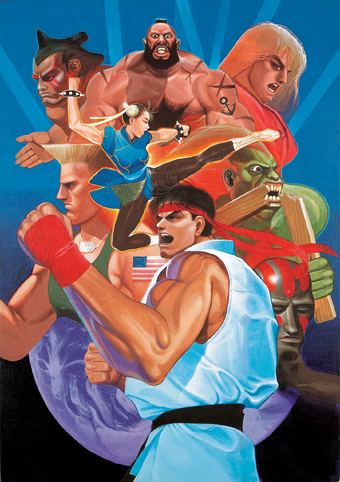
Japanese Cover Art by Akiman
| Returning characters |
|---|
| Ken Masters |
| Ryu |
| Sagat |
| New characters |
|---|
| Balrog |
| Blanka |
| Chun-Li |
| Dhalsim |
| E. Honda |
| Guile |
| M. Bison |
| Vega |
| Zangief |
| Introduced in Super Street Fighter II |
|---|
| Cammy |
| Dee Jay |
| Fei Long |
| T. Hawk |
| Introduced in Super Street Fighter II Turbo |
|---|
| Akuma (Secret Character) |
| Added or introduced in Ultra Street Fighter II: The Final Challengers |
|---|
| Evil Ryu |
| Violent Ken |
Development
Although the original Street Fighter had not been very popular, Capcom began to make fighting games a priority after Final Fight was commercially successful in the United States.[1] Yoshiki Okamoto recounted, "The basic idea at Capcom was to revive Street Fighter, a good game concept, to make it a better-playing arcade game."[2] About 35 to 40 people worked on Street Fighter II, with Noritaka Funamizu as a producer, and Akira Nishitani and Akira Yasuda in charge of the game and character design, respectively.[3][1] Funamizu notes that the developers did not particularly prioritize Street Fighter II's balance; he primarily ascribes the game's success to its appealing animation patterns.[1] The quality of animation benefited from the developers' use of the CPS-1 hardware, the advantages of which included the ability for different characters to occupy different amounts of memory; for example, Ryu could take up 8Mbit and Zangief 12Mbit.[1] The game's development took two years.[1]
The game's combo system came about by accident. Noritaka Funamizu stated: "While I was making a bug check during the car bonus stage… I noticed something strange, curious. I taped the sequence and we saw that during the punch timing, it was possible to add a second hit and so on. I thought this was something impossible to make useful inside a game, as the timing balance was so hard to catch. So we decided to leave the feature as a hidden one. The most interesting thing is that this became the base for future titles. Later we were able to make the timing more comfortable and the combo into a real feature. In SFII we thought if you got the perfect timing you could place several hits, up to four I think. Then we managed to place eight! A bug? Maybe."[1]
The vast majority of the in-game music was composed by Yoko Shimomura. This was ultimately the only game in the series on which Shimomura worked, as she subsequently left the company for Square two years later. Isao Abe, a Capcom newcomer, handled a few additional tracks ("Versus Screen", "Sagat's Theme", and "Here Comes A New Challenger") for this game and subsequently became the main composer on the remaining Street Fighter II games. The sound programming and sound effects were overseen by Yoshihiro Sakaguchi, who had been the composer on the original Street Fighter.
Regional differences
With the exception of Sagat, the Grand Masters bosses have different names in the Japanese version. The African-American boxer known as Balrog in the international versions was designed as a pastiche of real-life boxer Mike Tyson and was originally named M. Bison (short for "Mike Bison"), while Vega and M. Bison were originally named Balrog and Vega, respectively. When Street Fighter II was localized for the overseas market, the names of the bosses were rotated, fearing that the boxer's similarities to Tyson could have led to a likeness infringement lawsuit.[4] This name change would be carried over to future games in the series. To avoid confusion in Tournament Play, many players refer to each character by a defining characteristic. The names are "Claw" to refer to the character from Spain, "Boxer" to refer to the African-American boxer, and "Dictator" to refer to the final boss of the game.
The characters in the Japanese version also have more than one win quote[5] and if the player loses a match against the CPU in the Japanese version, a random playing tip will be shown at the bottom of the continue screen. While the ending text for the characters was originally translated literally, a few changes were made due to creative differences from Capcom's U.S. marketing staff. For example, the name of Guile's fallen friend (who would later debut as a playable fighter in Street Fighter Alpha) was changed from Nash to Charlie, since a staff member from Capcom USA felt that Nash was not a natural sounding English name.[3]
Versions
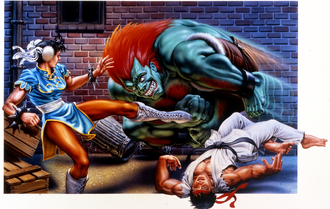
Street Fighter II U.S. Cover Art, by Mick McGinty
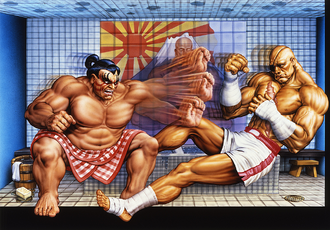
Street Fighter II Turbo U.S. Cover Art, by Mick McGinty
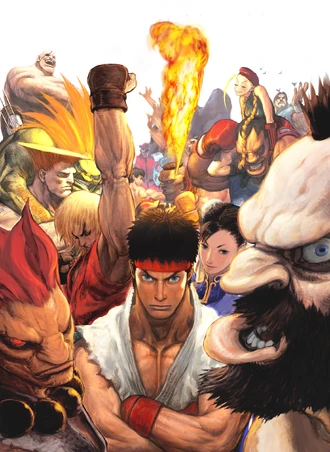
Hyper Street Fighter II/Anniversary Collection Cover Art
Street Fighter II: The World Warrior
Street Fighter II: The World Warrior, the first iteration of the Street Fighter II series, was released in March 1991. The game featured all the basic features that would be carried over to subsequent Street Fighter II editions. The original game featured eight selectable characters, with Ryu and Ken being the only characters with identical moves. In the single-player tournament, the player faces against the other seven main characters, before proceeding to the final four opponents, which were non-selectable boss characters. In World Warrior, matches could go up to ten rounds if there were no clear winner before making the player lose by default (from Champion Edition onward, this was reduced to four rounds).
Street Fighter II': Champion Edition
Street Fighter II': Champion Edition, released in Japan in 1992 as Street Fighter II Dash (ストリートファイターIIダッシュ, Sutorīto Faitā Tsū Dasshu?).
- All four boss characters became playable. This also marks Sagat's first time being playable.
- Players could choose the same character to fight against each other, using palette swapping (different colors) to differentiate the second player.
- The backgrounds of each player's stage were re-colored (a theme throughout most of the revisions).
- There were various bug fixes for serious glitches (such as Guile's Handcuffs), as well as some balancing of the characters.
Street Fighter II Turbo: Hyper Fighting
Street Fighter II Turbo: Hyper Fighting, released in Japan as Street Fighter II Dash Turbo, was made in response to the proliferation of modified bootlegs of Champion Edition. It was released only eight months after Champion Edition in 1992. Changes included:
- Faster gameplay.
- Many characters gained new moves (all composed of recycled animation frames), and several that could now be performed in mid-air.
- All characters were given new, default color palettes, with their original color scheme accessible as an alternate color scheme (replacing the ones from Champion Edition). The only exception to this was the final boss, M. Bison, who still used his original color scheme by default, but was given a new alternate color scheme anyway.
Super Street Fighter II: The New Challengers
Super Street Fighter II: The New Challengers (スーパーストリートファイターII, Sūpā Sutorīto Faitā Tsū?) was the first Street Fighter game that Capcom would release on its CPS-2 hardware. The 1993 arcade version of this game also included a variant titled Super Street Fighter II: Tournament Battle that allowed four arcade cabinets to be connected together for simultaneous tournament play. This version contained the most extensive changes introduced in the series:
- Four new characters were added (Fei Long, T. Hawk, Cammy, and Dee Jay).
- Boss characters received updated regular move sets.
- Boss characters received new, individual game endings.
- Each character could be selected with one of eight different color palettes.
- Some of the original eight playable characters received updated art and audio.
- The speed introduced in Hyper Fighting was reduced.
- A combo counter (a first despite combos being in the game since the original), as well as point bonuses for first attack, combos and reversals.
Super Street Fighter II Turbo
Super Street Fighter II Turbo, or Super Street Fighter II X: Grand Master Challenge (スーパーストリートファイターII X, Sūpā Sutorīto Faitā Tsū Ekusu?, "Two Ex") in Japan, is a slightly updated version of Super Street Fighter II. This version, released in 1994, introduced:
- The addition of the "SUPER" bar. This allowed character to build up and unleash a very powerful special attack. This same technique would be used in a lot of Capcom fighting games to come.
- The speed was again raised from Super SF2, close to Turbo: Hyper Fighting levels.
- Intentional air juggling (a series of attacks that could hit an opponent while airborne).
- The ability to tech or "soften" non-multi hit throws (teching allows a character to land on one's feet instead of on their back, resulting in less damage).
- A new secret character (Akuma).
- Alternate versions of each character with similar characteristics (but not quite identical) to their Super Street Fighter II versions.
- The bonus stages (where players try to destroy all the objects in the stage before time runs out) were removed.
- Super Street Fighter II Turbo Revival was the name of the 2001 GBA version.
Compilations
- Street Fighter Collection - a compilation that contained Super Street Fighter II (and Turbo) and Street Fighter Alpha 2 Gold, was released for the PlayStation and Saturn in 1997. All three games were close to their arcade counterparts.
- Street Fighter Collection 2 - a second compilation that contained Street Fighter II: The World Warrior, Street Fighter II': Champion Edition and Street Fighter II Turbo: Hyper Fighting. This was released in Japan as the final volume in the Capcom Generations series.
- Hyper Street Fighter II: The Anniversary Edition (ハイパーストリートファイターII, Haipā Sutorīto Faitā Tsū?) is an arranged version of Super Street Fighter II Turbo with the ability to choose every previously playable version of the characters from all five arcade versions of Street Fighter II (including the alternate versions of the characters in Super Turbo). It was first released as a PlayStation 2 game, but was backported to the CPS-2 hardware and distributed in arcades in Japan and Asia. The game includes an option to switch between the CPS (with Sharp X68000 versions for themes from Super), CPS-2 and arranged (from the FM Towns version of Super and the 3DO version of Super Turbo) renditions of the game's soundtrack. The PS2 version of the game was sold as a stand-alone game in Japan and in the PAL region, and bundled with Street Fighter III 3rd Strike retitled Street Fighter Anniversary Collection in North America. This same bundle was released worldwide for the Xbox.
Reception
Commercial reception
Adjusted for inflation in 2016, all versions of Street Fighter II are estimated to have grossed a total of $10.61 billion in revenue, mostly from the arcade market. This makes it one of the top three highest-grossing video games of all time, after Space Invaders (1978) and Pac-Man (1980).[6]
Legacy
Sequels
The Street Fighter II games were followed by several sub-series of Street Fighter games and spinoffs which include Street Fighter Alpha, Street Fighter EX, Street Fighter III, Pocket Fighter, Super Puzzle Fighter II Turbo and Capcom's Vs. series (which combined Capcom's characters with properties from other companies such as Marvel, SNK, and Tatsunoko). Capcom released Street Fighter IV for the arcades in July 2008, followed by the release for the Xbox 360 and PlayStation 3 consoles in February 2009 and for Microsoft Windows in July 2009. Most recently, Street Fighter V was released for the PlayStation 4 and PC in 2016.
Impact
Street Fighter II is regarded as one of the most influential video games of all time,[7][8][9] and the most important fighting game in particular.[9][10][11] The release of Street Fighter II in 1991 is often considered a revolutionary moment in the fighting game genre. It featured the most accurate joystick and button scanning routine in the genre thus far, allowed players to reliably execute multi-button special moves (which had previously required an element of luck), and its graphics took advantage of Capcom's CPS arcade chipset, with highly detailed characters and stages. Whereas previous games allowed players to combat a variety of computer-controlled fighters, Street Fighter II allowed players to play against each other. The popularity of Street Fighter II surprised the gaming industry, as arcade owners bought more machines to keep up with demand.[12] Street Fighter II was also responsible for introducing the combo mechanic to the general audince, which came about when skilled players learned that they could combine several attacks that left no time for the opponent to recover if they timed them correctly.[1][8][13]http://www.1up.com/features/street-fighter-ii-things-you-did-not-know</ref> Its success inspired a wave of other fighting games, which were and still are often labeled as "clones",[7][14] including popular franchises such as Mortal Kombat[15] and The King of Fighters.
Street Fighter II was also responsible for revitalizing the arcade video game industry in the early 1990s,[7][8] to a level of popularity not seen since the days of Pac-Man in the early 1980s;[8][11] It was the best-selling arcade video game by far since the golden age of arcade video games,[8][11] setting off a renaissance for the arcade game industry in the early 1990s.[16] Its impact on home video games was equally important, with its release being a major event that boosted sales of the Super Nintendo Entertainment System and became a long-lasting system-seller for the platform.[7] Since then, numerous best-selling home video games have been arcade ports.[17]
The game was also responsible for popularizing the concept of direct, tournament-level competition between two players.[7] Previously, video games most often relied on high scores to determine the best player, but this changed with Street Fighter II, where players would instead challenge each other directly, "face-to-face," to determine the best player,[7] paving the way for the competitive multiplayer and deathmatch modes found in modern action games.[9] John Romero, for example, cited the competitive multiplayer of Street Fighter II as an influence on the deathmatch mode of seminal first-person shooter Doom.[18]
Another impact it had on the gaming industry was the concept of revisions, with Capcom continuously upgrading and expanding the arcade game instead of simply releasing a sequel, paving the way for the patches and downloadable content found in modern video games.[7]
Popular culture
Street Fighter II has been influential in hip hop culture, as the video game most frequently sampled and referenced in hip hop music. It has been referenced in the lyrics of songs by rappers such as Nicki Minaj, Lupe Fiasco, Dizzee Rascal, Lil B, Sean Price, and Madlib, for example. The connection between Street Fighter and hip hop dates back to Hi-C's "Swing'n" (1993) and DJ Qbert's "Track 10" (1994) which sampled Street Fighter II, and the Street Fighter film soundtrack (1994) which was the first major film soundtrack to consist almost entirely of hip hop music. According to DJ Qbert, "I think hip-hop is a cool thing, I think Street Fighter is a cool thing". According to Vice magazine, "Street Fighter's mixture of competition, bravado, and individualism easily translate into the trials and travails of a rapper."[19]
Street Fighter II has been similarly influential in UK rap culture, frequently referenced and sampled in grime music. According to grime DJ Logan Sama, "Street Fighter is just a huge cultural thing that everyone experienced growing up, the characters are hugely recognisable as well as the moves", and it "had such a huge impact that it has just stayed in everyone’s consciousness." According to Jake Hawkes of Soapbox, "grime was built around lyrical clashes" and "the 1v1 setup of these clashes was easily equated with Street Fighter's 1 on 1 battles." Grime MCs such as Dizzee Rascal were sampling Street Fighter II as early as 2002, and Street Fighter II has since been sampled "by almost every grime MC at one time or another". Street Fighter II became established in grime culture to the point of becoming an integral part of BBC Radio 1Xtra DJ Charlie Sloth's Fire in the Booth freestyle segments, using samples such as "Hadouken", "Shoryuken" and the "Perfect" announcer sound.[20] The "Perfect" announcer sample has also been used to tag verses by North American rappers.
WhoSampled lists about 80 songs that have sampled Street Fighter II, including songs by artists such as Jay-Z, Drake, Psy, Dizzee Rascal, Lupe Fiasco, Bryson Tiller, and A Guy Called Gerald, among many others.[21] "Hadouken!" was also the name of a British grindie band.[20] The diss track for Mia Khalifa by iLOVEFRiDAY, titled "Mia Khalifa", uses sound effects from Street Fighter II, including the Capcom logo jingle, and the "Fight!" announcer clip.
Trivia
- A little known fact is that makes Ken more desirable in high level play is that in The World Warrior Ryu has a single frame in his stun animation[22] where he takes double damage from any attack (similar how Blanka would take double damage if he is hit out of his Blanka Ball or Sagat if he is hit before Tiger Uppercut recovers) while Ken does not. This can usually be seen in Tool Assisted videos.
Credits
Arcade Version [Street Fighter II]
Planner.: Nin, Akiman
Character Designer: S.Y, Ikusan.Z, Sho, Erichan, Pigmon, Katuragi, Mak!!, Manbou, Ballboy, Kurisan, Q Kyoku, Mikiman, Tanuki, Yamachan, S・Taing, Nissui, Buppo, Ziggy, Zummy, Nakamura, Okazaki
Programmer: Shin., Marina, Macchan, Ecchro!
Sound: Shimo-P., Oyaji Oyaji
Special Thanks: CBX and Poo, Kanekon, Shono.
Presented by: Capcom®
Arcade Version [Champion Edition]
Planner: Nin, Akiman
Character Designer: S.Y, Sho, Pigmon, Ikusan.Z, Erichan, Katuragi, Mak!!, Ballboy, Q Kyoku, Tanuki, S・Taing?, Manbou, Kurisan, Mikiman, Yamachan, Nissui, Buppo, Zummy, Ziggy, Y.Nakamura, M.Okazaki
Programmer: Shin., Marina, Macchan, E Oyaji!, Hirakin!
Sound: Shimo-P., Oyaji Oyaji.
Special Thanks: CBX, Poo, Kanekon, Shono, Nac Kai, Erlingr Ogachy, DJames
Presented by: Capcom®
SNES Version [Street Fighter II] [SNSP Street Fighter Ⅱ Staff]
Planner: Nin Nin
Software Design: Koji "Yoshilim" Yoshida, Seiji "Coco★Azusa" Okada, Harunobu "Img" Imagawa, Yoshihiro "Macchan" Matsui, Kowichiro "Kow" Nakamura, Hisashi "Roy" Kuramoto
Sound Design: Yoshihiro "Oyabun" Sakaguchi, Youko "P♪" Shimomura, Tatsuya "Anie" Nishimura, Isao "Oyaji" Abe
Object Design: Masao "Sakusan" Sakurai, Wild Cats, Hidetoshi "Arashi" Kai, Takashi "Mighty" Hama, Hironori "Fishman" Matsumura, Hayato "Drill" Kaji, Satoshi "Ukashisu" Ukai
Scroll Design: Shizuyo "Kix" Ukai, Ryutaro's Mama, Chieko Ryugo, Jun "Bunny" Takeuchi
Very Special Thanks: Hisashi "MX-5" Yamamoto, Shin, Akiman, Street Fighter Ⅱ Arcade Staff
Special Thanks: Haggar, Kiyomi "Kanekon" Kaneko, Masayuki "Imo" Akahori, Mickey, Bamboo, Kamecha, Duke, Yamazou, Linda, H.Hiroyuki, Aeg, Yasuko Watanabe, Capcom All Staff
Arcade Version [Turbo]
Planner: Nin, Akiman
Character Designer: S.Y, Ikusan.Z, Sho, Erichan, Pigmon, Katuragi, Mak!!, Manbou, Ballboy, Kurisan, Q Kyoku, Mikiman, Tanuki, Yamachan, S・Taing, Nissui, Buppo, Ziggy, Zummy, Nakamura, Okazaki
Programmer: Shin., Marina, Macchan, Ecchro!!
Sound: Shimo-P., Oyaji Oyaji
Design Support: D.James
Special Thanks: CBX and Poo, Kanekon, Shono., Hirakin., Nac Kai, Erlingr Ogachy, Zenji., Super・Cheap・Joe
Presented by: Capcom®
TurboGrafx-16 Version [Champion Edition] [Street Fighter Ⅱ Staff]
Planner: Hyper Mickey
Software Design: Koji "Yoshilim" Yoshida, Koji "Cuty" Ueyama, Harunobu "Img" Imagawa, Hisashi "Kurarin" Kuramoto, Hiroki "Chun" Bandoh, Mitsutoshi "Mit" Gotoh
Sound Software Design: Yoshihiro "Oyabun" Sakaguchi, Yasushi "Ikebomb" Ikeda
Music Design: Mari Yamaguchi, Isao "Oyaji" Abe
Sound Effect Design: Tatsuya "Anie" Nishimura, Tadashi "Elf" Joukagi
Object Design: Masao "Sakusan" Sakurai, Kaijin Pe.Pe.Pe
Scroll Design: Shizuyo "Izzy" Ukai, Chie "Tanoq" Nishida
Technical Design: Nobuhiro "Nob" Takagaki, Yasunobu "Planet" Kasuya, Takato Matsumura
Market Design: Masao "Tekesan" Takeuchi, Yoshiro "Single" Suzuki, Nobuyuki "Kon" Kondoh, Hideaki Azima, Meg, Hirotada "Baco" Hashimoto
Very Special Thanks: Tadashi "Breath" Sanzen, Manashi, Masayuki "Imo" Akahori, Professor F, Mizushima Ya.
Special Thanks: Shin, Ryo Miyazaki, Noriko "Cozy" Aiba, Pukuch, PC Tompon, Hyper Bengie, Hanaten "Uckey" Sarujima, Key Mountain
Produced by: Capcom Co., Ltd.
Presented by: NEC Home Electronics, Ltd.
SNES Version [Turbo] [SNES Street Fighter Ⅱ Turbo Staff]
Planner: Tatsuya "Mickey" Minami
Software Design: Koji "Yoshilim" Yoshida, Seiji "Senou Azusa" Okada, Kiyomi "Kanekon" Kaneko, Koji "Cuty" Ueyama, Harunobu "Img" Imagawa, Hisashi "Kurarin" Kuramoto, Tadashi "Sanchan" Sanzen, Syuichiroh "Luck" Chiboshisan, Hiroki "Chun" Bandoh
Sound Design: Yoshihiro "Oyabun" Sakaguchi, Yasushi "Ikebomb" Ikeda
Music Design: Isao "Oyaji" Abe, Yuki "3D" Satomura
Sound Effect: Tatsuya "Anie" Nishimura
Object Design: Masao "Sakusan" Sakurai, Kaijin Pe.Pe.Pe, Hironori "Fishman" Matsumura, Hidetoshi "Arashi" Kai, Takashi "Mighty" Hama, "Sailormoon" Saitoh
Scroll Design: Shizuyo "Izzy" Ukai, Chie "Tanoq" Nishida
Very Special Thanks: Masayuki "Imo" Akahori, Professor F, Mizushima Ya.
Special Thanks: Manashi, Zi Zi, Ukakichi, F2 Character Staff, Wa! Oh!, Key Mountain, Miss Omaya, Capcom All Staff
Presented by: Capcom
Genesis/Mega Drive Version [Special Champion Edition] [Mega Drive Street Fighter ⅡSpecial Champion Edition Staff]
Planner: Tatsuya "Mickey" Minami
Software Design: Yoshito "Leo" Itoh, Tomoyuki "E-Hito" Ohta, Koji "Yoshilim" Yoshida, Kiyomi "Kanekon" Kaneko, Harunobu "Img" Imagawa, Koji "Cuty" Ueyama, Hisashi "Kurarin" Kuramoto, Tadashi "Sanchan" Sanzen, Syuichiroh "Luck" Chiboshi, Hiroki "Chun" Bandoh
Music Design: Tadashi "Elf" Joukagi, Setsuo "Kashira" Yamamoto
Sound Design: Tatsuya "Anie" Nishimura, Tadashi "Elf" Joukagi
Object Design: Masao "Sakusan" Sakurai, "Nabe-Chan" Mayumi, Akemi "Zizi" Iwasaki, Hajime‑Chan, Naokazu "Sailor-V" Saitoh
Scroll Design: Shizuyo "R.H.C.P." Ukai, Ryutaro's Mama, Jun "Bunny" Takeuti, Joe Yabuki
Very Special Thanks: Masayuki "Imo" Akahori, Professor F
Special Thanks: Hyper Bengie, Mizushima "Afh"‑Ya., Mr. Sawalim, Factory Matsubara, Hironobu Takeshita, Mr. Makino, Osu Nakajima, Capcom All Staff, and You
Presented by: Capcom
Master System Version [Dash] [Street Fighter II for Master System Staff]
Planner: Tatsuya "Mickey" Minami
Software Design: Yoshito "Leu" Itoh, Tomuyuki "E-Hito" Ohia, Koji "Yoshilim" Yoshida, Kiyomi "Kanekon" Kaneko, Harunobu "Imc" Imagawa, Koji "Cuty" Ueayama, Hisashi "Kurabin" Kuramoto, Tadashi "Sanchan" Sanzen, Syuchiroh "Lucky" Chiboshi, Hiroki "Chun" Bandoh, Mauricio Antonio Guerta, Heriberto Martinez Manrique, Luis Carlos Ferreira, Flavia de Cassia Gardin, Elielson Antonio Salaro, Joyce Reco Tendero, Nivaldo Carriao, Ana Rita M. Vieira, Luís Carlos Campello, Helio Fujimoto, Luiz Carlos de Moraes, Eliton Donizete Lomba, Edgard Satoshi Fujisawa, Druzolina Viol Salaro, "Dog" Golias, "Dog" Tanga e Ufo, Mr. Loper
Music Design: Tadashi "Elf" Joukagi, Setsuo "Kashira" Yamamoto
Sound Design: Tatsuya "Anie" Nishimura, Tadashi "Elf" Joukagi
Object Design: Masao "Sakusan" Sakurai, "Nabe-Chan" Mayumi, Akemi "Zizi" Imasaki, Hajime‑Chan, Naokazu "Sailor-V" Saitoh
Scroll Design: Shizuyo "R.H.C.P" Ukai, Ryutaros Mama, Jun "Bunny" Takeuti, Joe Tabuki
Testers: Edson Takeshi Nakaya, Juliano Barboza de Oliveira, Daniel Trevisan
Very Special Thanks: Masayoki "Imo" Akahori, Professor F
Special Thanks: Hyper Bengie, Mizushima "Afh"‑Ya., Mr. Sahalim, Factory Matsubara, Hironobu Takeshita, Mr. Makino, Osu Nakajima, Willian Roger Zampolli, Capcom All Staff, TecToy All Staff, and You
Presented by: Capcom, TecToy
Gallery
Box Art
Media and Merchandise
Manga
UDON comics
References
- ↑ 1.0 1.1 1.2 1.3 1.4 1.5 1.6 Cite error: Invalid
<ref>tag; no text was provided for refs namedEdge-Makingof - ↑ cite news|last= |first= |title=Interview: The Men Who Make Street Fighter II!|work=GamePro|issue=59|publisher=IDG|date=June 1994|page=32
- ↑ 3.0 3.1 http://www.polygon.com/a/street-fighter-2-oral-history/
- ↑ https://web.archive.org/web/20070423095618/http://www.capcom.co.jp/sound/topics/tpcs1_2.html
- ↑ http://meh.brpxqzme.net/sf2/message.html
- ↑ World of Warcraft Leads Industry With Nearly $10 Billion In Revenue (26 January 2017). Retrieved on 9 January 2019.
- ↑ 7.0 7.1 7.2 7.3 7.4 7.5 7.6 http://www.egmnow.com/articles/news/egm-featurethe-5-most-influential-japanese-gamesday-four-street-fighter-ii/
- ↑ 8.0 8.1 8.2 8.3 8.4 http://www.1up.com/features/essential-50-street-fighter-ii
- ↑ 9.0 9.1 9.2 cite book|title=Vintage games: an insider look at the history of Grand Theft Auto, Super Mario, and the most influential games of all time|year=2009|publisher=Focal Press/Elsevier|location=Boston|isbn=0-240-81146-1|pages=239–255|url=https://books.google.com/books?id=M_bFdsP9L7oC%7Cauthor=Matt Barton|author2=Bill Loguidice |accessdate=April 17, 2012
- ↑ https://web.archive.org/web/20130509120323/http://www.1up.com/features/20-years-street-fighter-ii
- ↑ 11.0 11.1 11.2 Spencer, Spanner, The Tao of Beat-'em-ups (part 2), EuroGamer, February 12, 2008, Accessed March 18, 2009
- ↑ http://www.gamespot.com/features/vgs/universal/sfhistory/history.html
- ↑ http://top100.ign.com/2007/ign_top_game_24.html
- ↑ cite magazine |title=What If Street Fighter 3 Isn't Good?|magazine=Electronic Gaming Monthly|issue=88 |publisher=Ziff Davis|date=November 1996 |page=278|quote=It is not the first 2-D one-on-one fighter, but it was leaps and bounds over the competition in terms of graphics, sounds and most importantly, gameplay. Because of this success, countless clones were produced, including many by Capcom themselves.
- ↑ https://www.nytimes.com/2002/07/08/technology/08MIDW.html
- ↑ https://www.theverge.com/2013/1/16/3740422/the-life-and-death-of-the-american-arcade-for-amusement-only
- ↑ cite book|work=Digital illusion: entertaining the future with high technology|chapter=30|title=Coin-Op: The Life (Arcade Videogames)|author=Mark Stephen Pierce (Atari Games Corporation)|publisher=ACM Press|year=1998|isbn=0-201-84780-9|url=http://www.communication.illinois.edu/csandvig/classes/Pierce.pdf%7Carchiveurl=https://web.archive.org/web/20111006195101/http://www.communication.illinois.edu/csandvig/classes/Pierce.pdf%7Carchivedate=2011-10-06%7Caccessdate=May 2, 2011|page=444
- ↑ cite book|last=Consalvo|first=Mia|year=2016|title=Atari to Zelda: Japan's Videogames in Global Contexts|pages=201–3|url=https://books.google.com/books?id=tH3TCwAAQBAJ&pg=PA201%7Cpublisher=MIT Press|isbn=0262034395
- ↑ https://waypoint.vice.com/en_us/article/ypvx7k/the-long-strange-history-of-street-fighter-and-hip-hop
- ↑ 20.0 20.1 http://www.spbx.co.uk/grime-music-and-street-fighter-a-history/
- ↑ https://www.whosampled.com/Yoko-Shimomura/
- ↑


